|

First published: 1998
Last updated: March 16, 2024
This feature is based on the research done by Mr. Yasuaki Deguchi and his third son, Mr. Hisashi Deguchi, about the Kirigami Shinji (Cut-Paper Revelation).
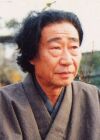
Mr. Yasuaki Deguchi |
| 
Mr. Hisashi Deguchi |
Their works cited in this feature are as follows:
For the complete list of works cited, see Bibliography.
|
- (Left) The Daily Mainichi's Dec. 10, 1978 article on the discovery of Prince Taruhito's daggers for defense.
- (Right) Of the two daggers, the prince gave the left one to Yone and the right one to their child (Onisaburo). Each dagger has the Imperial Chrysanthemum Crest on its haft.
|
A True Serendipity
A man from Tokyo dropped by the residence of Mr. Yasuaki Deguchi (a grandson of Onisaburo) in Kyoto on January 19, Heisei 10 (1998). This date happened to mark the 50th anniversary of Onisaburo's ascention to heaven.
Mr. Deguchi offered him a stay at the Kumano House (Onisaburo named his former residence this way) because it was already dark out, and this publisher (Mr. Fujii) idly browsed in Mr. Deguchi's personal library until dinner was ready.
At the dinner table, Mr. Deguchi happened to talk about Emperor Kohmei and the Kirigami Shinji. He recounted his experience of learning the cut-paper art from Yasukuni Doi, a senior disciple of Onisaburo, when he was a middle school student. He went on to say that the Kirigami Shinji was something Emperor Kohmei had taught to his bodyguard-turned sumo wrestler.
What Mr. Deguchi said rang a bell for Mr. Fujii, and he ran to Mr. Deguchi's personal library and came back with an old dusty box in his hands. It contained some newspaper cutouts, 10 numerical tables, and four booklets on what is claimed to be a "divine art of the Imperial Nation (Japan)" - namely, the Kirigami Shinji (Cut Paper Revelation).
The old box made Mr. Deguchi remember that Mr. Doi's wife gave it to him when her husband passed away on January 9, Showa 39 (1964). Mr. Deguchi had long consigned it to oblivion, but it resurfaced in his memory for the first time in 34 years - on the 50th anniversary of Onisaburo's ascesion to heaven - as if Onisaburo gave instructions to his grandson.
"Yasuaki, reveal the truth about the Kirigami Shinji."
This was the message Mr. Deguchi thought he received from his grandfather.
Given its background and significance, the Kirigami Shinji can revolutionize the general perception of the country's Imperial history after the Meiji era, Onisaburo Deguchi, and his "divine theatrical troupe" called Omoto.
 A numerical table
What is the Kirigami Shinji?
The Kirigami Shinji is a kind of divine revelation based on the cut-paper art where the use of all the nine cut pieces creates meaningful characters, such as:
 (cross; symbol of God) and HELL, and (cross; symbol of God) and HELL, and
 (cross) and LOVE (a variation of HELL) (cross) and LOVE (a variation of HELL)
Some readers may be familiar with it as some Christian missionaries often use this technique for their missions.
Then, did you know this art also produces the following character strings?:
| 1 |  and and  : God and akuma (Japanese word for "devil") : God and akuma (Japanese word for "devil")
|
| 2 |  : kami (Japanese word for "god," "deity") : kami (Japanese word for "god," "deity")
|
| 3 |  and and  : ka (fire) and mi (water) = kami. In Shinto, Kami is often synonymous with fire and water. : ka (fire) and mi (water) = kami. In Shinto, Kami is often synonymous with fire and water.
|
| 4 |  and and  : sukuhi (salvation) and God, and together it can also mean a "saviour deity." : sukuhi (salvation) and God, and together it can also mean a "saviour deity."
|
| 5 |  : miroku (Japanese word for "Maitreya") : miroku (Japanese word for "Maitreya")
|
| 6 |  and and  : God and Taniha (Tamba; region including Ayabe and Kameoka, where the Omoto faith was born) : God and Taniha (Tamba; region including Ayabe and Kameoka, where the Omoto faith was born)
|
| 7 |  and and  : God and Ayabe (place where one of Omoto's holy sanctuaries is located) : God and Ayabe (place where one of Omoto's holy sanctuaries is located)
|
| 8 |  : Omoto : Omoto
|
| 9 |  : ushitora (Ushitora no Konjin; Kunitokotachi no Mikoto) : ushitora (Ushitora no Konjin; Kunitokotachi no Mikoto)
|
| 10 |  : hitsujisaru (Hitsujisaru no Konjin. Her real name is Toyokumonu no Mikoto, the wife-deity of Kunitokotachi no Mikoto. Also a manifestation of Kamususanowo no Ohkami) : hitsujisaru (Hitsujisaru no Konjin. Her real name is Toyokumonu no Mikoto, the wife-deity of Kunitokotachi no Mikoto. Also a manifestation of Kamususanowo no Ohkami)
|
| 11 |  : Deguchi (the Deguchi family) : Deguchi (the Deguchi family)
|
| 12 |  (or (or  ) and ) and  (or (or  ) : Nao [or Naka] and Oni [or Wani ] (Nao and Onisaburo Deguchi, founders of Omoto. Nao's name on the family register was Naka. Onisaburo was often dubbed Wani-san) ) : Nao [or Naka] and Oni [or Wani ] (Nao and Onisaburo Deguchi, founders of Omoto. Nao's name on the family register was Naka. Onisaburo was often dubbed Wani-san)
|
| 13 |  : Sumiko (Omoto's Second Spiritual Leader Sumi Deguchi, the youngest daughter of Nao. Sumi was called either Sumi or Sumiko) : Sumiko (Omoto's Second Spiritual Leader Sumi Deguchi, the youngest daughter of Nao. Sumi was called either Sumi or Sumiko)
|
| 14 |  : Naohi (Omoto's Third Spiritual Leader Naohi Deguchi, the eldest daughter of Onisaburo and Sumi) : Naohi (Omoto's Third Spiritual Leader Naohi Deguchi, the eldest daughter of Onisaburo and Sumi)
|
| 15 |  : Motowo (The real first name of Hidemaru Deguchi, Naohi's husband and the Deputy Third Spiritual Leader) : Motowo (The real first name of Hidemaru Deguchi, Naohi's husband and the Deputy Third Spiritual Leader)
|
| 16 |  : Taisho 10 (1921, the year when the Japanese authorities persecuted Omoto on Feb. 12 and destroyed its brand-new shrine atop Mt. Hongu in Ayabe on Oct. 20 by the solar calendar or Sep. 20 by the lunar calendar). : Taisho 10 (1921, the year when the Japanese authorities persecuted Omoto on Feb. 12 and destroyed its brand-new shrine atop Mt. Hongu in Ayabe on Oct. 20 by the solar calendar or Sep. 20 by the lunar calendar).
October 18 by the solar calendar, or September 18 by the lunar calendar, Taisho 10 (1921) is the time when Onisaburo started dictating his Reikai Monogatari to his scribes.
|
| 17 |  : jugatsu (October, the month on the solar calendar when Omoto's holy shrine started to be demolished [Oct. 20] or when Onisaburo started dictating his Reikai Monogatari to his scribes [Oct. 18]) : jugatsu (October, the month on the solar calendar when Omoto's holy shrine started to be demolished [Oct. 20] or when Onisaburo started dictating his Reikai Monogatari to his scribes [Oct. 18])
|
| 18 |  : kugatsu (September, the month on the lunar calendar when Omoto's holy shrine started to be demolished [Sep. 20] or when Onisaburo started dictating his Reikai Monogatari to his scribes [Sep. 18]) : kugatsu (September, the month on the lunar calendar when Omoto's holy shrine started to be demolished [Sep. 20] or when Onisaburo started dictating his Reikai Monogatari to his scribes [Sep. 18])
|
| 19 |  : juninichi (12th day, the day when the Japanese government suppressed Omoto [Feb. 12]) : juninichi (12th day, the day when the Japanese government suppressed Omoto [Feb. 12])
|
| 20 |  : hatsuka (20th day, the day when Omoto's holy shrine started to be demolished [either
Oct. 20 or Sep. 20]) : hatsuka (20th day, the day when Omoto's holy shrine started to be demolished [either
Oct. 20 or Sep. 20])
|
| 21 |  : gogoichi (1:00 PM, the hour when Omoto's holy shrine started to be demolished) : gogoichi (1:00 PM, the hour when Omoto's holy shrine started to be demolished)
|
| 22 |  : Hongu (small hill within Omoto's holy ground in Ayabe. Omoto's holy of holies, sort of. Also the site of the government suppression of the religious sect, better known as the First Omoto Incident) : Hongu (small hill within Omoto's holy ground in Ayabe. Omoto's holy of holies, sort of. Also the site of the government suppression of the religious sect, better known as the First Omoto Incident)
|
| 23 |  : juhachinichi (18th day, the day when the dictation of the Reikai Monogatari got under way on Oct. 18 by the solar calendar or Sep. 18 by the lunar calendar) : juhachinichi (18th day, the day when the dictation of the Reikai Monogatari got under way on Oct. 18 by the solar calendar or Sep. 18 by the lunar calendar)
|
| 24 |  : Nippon (kanji characters for "Japan") : Nippon (kanji characters for "Japan")
|
| 25 |  : Beikoku (kanji characters for the "United States of America." : Beikoku (kanji characters for the "United States of America."  is a simplified form of is a simplified form of 
|
As you can see, what is called the Kirigami Shinji (Cut-Paper Revelation) prophesies the founding of the Omoto faith in the Tamba region including Ayabe, the emergence of Nao and Onisaburo Deguchi, and the battle between the Kami and the Devil on Mt. Hongu, costing Omoto's holy shrines yet triggering the dictation of the everlasting gospel, The Reikai Monogatari (Tales of the Spirit World).
The above combinations employ all of the nine cut pieces - with no shortage or superfluity - and they come out in an orderly fashion. Moreover, Japanese words (kana syllabaries and kanji characters) are produced in great numbers. Given the basic theorems of probability, this is by no means a coincidence but a great work of the Creator.
Sources of the Kirigami Shinji
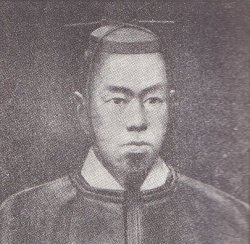 Emperor Kohmei (1831-1866)
The Kirigami Shinji is of obscure origin, but it can trace back to several possible sources.
One has to do with with a paper-cutting competition in Britain or perhaps France. Sponsered by a local newspaper company, this contest looked for ways to create the Christian cross with just one scissor cut, and a female contestant won the prize for what is now identical to the Kirigami Shinji.
Another comes from an Omoto believer named Hara. He practiced medicine in Taiwan around Taisho 8 (1919) or Taisho 9 (1920). By mere chance, he discovered the Kirigami Shinji, and it later spread among Omoto believers in Japan.
Still another source is based on the four handwritten booklets found at the Kumano House (Mr. Deguchi's residence). They indicate that Japan's Emperor Kohmei (1831-1866; See image above) conferred this cut-paper art upon one of his Imperial Palace guards, Kametaro Asahigata, for his daring rescue of the Emperor during the Kinmon Incident of 1894 (Kinmon refers to a gate of the Imperial Palace in Kyoto), where the Choshu domain fought with the Aizu and Satsuma domains in a bid to regain influence in the Tokugawa Shogunate.
While these are sources known to us so far, other little known sources also exist. For example, this cut-paper art has spread to the Shinshu-kyo religion through a mysterious process.
Kenji Miyazawa (1896-1933), a great Japanese novelist and poet, also mentions this art in his 119-verse poem titled the Okhotsk Banka (Okhotsk Elegy) as it was published in August 4, Taisho 12 (1923). In it, Miyazawa admits that he sneered at his sister Toshiko when she created a cross ( ) and HELL with some wood pieces and then changed HELL to LOVE because it was a common practice in those days. Since Toshiko died in November, Taisho 11 (1922), the Kirigami Shinji must have been popular in those days if the story is true. ) and HELL with some wood pieces and then changed HELL to LOVE because it was a common practice in those days. Since Toshiko died in November, Taisho 11 (1922), the Kirigami Shinji must have been popular in those days if the story is true.
For more about Kenji Miyazawa, see the following:
A much more recent anecdote has it that on January 3, Heisei 10 (1998), Mr. Hisaya Morishige, a senior Japanese actor, demonstrated the Kirigami Shinji in an NHK (Japan's national TV network) program titled Futari no Big Show (A Big Show by Two People) with Ms. Akiko Wada, a senior Japanese singer. Mr. Yasuaki Deguchi called Mr. Morishige's residence, and his son who happened to pick up the phone while he was away, told him that Morishige had learned the cut-paper art from a non-Japanese national at a gathering.
Onisaburo's Riddle?
In the January, Taisho 10 (1921) issue of the Shinreikai (World of Divine Spirits), one of Omoto's in-house magazines, Onisaburo quoted the Tokyo-based Yamato Daily as saying:
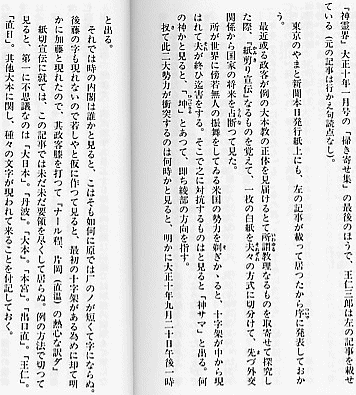 An article in the Yamato Daily about the Kirigami Shinji
(Brief Summary)
- A politician recently did some research on Omoto's teachings to uncover its true identity, and learned the Kamikiri Senden (Cut-Paper Advertising = the Kirigami Shinji). With this technique, he tried telling the fortune of Japan and its diplomatic relations.
- Two major forces - Kami and Akuma (Devil) - appear, and the former is the Deity Hitsujisaru, a symbolic reference to Omoto's holy sanctuaries in Ayabe.
- The time when these forces will clash with each other is September 20, Taisho 10 (1921) at 1:00 p.m.
- Under whose cabinet will this showdown take place? The cut paper pieces say it is not (Prime Minister) Hara nor Goto but Kato.
- The Kamikiri Senden also produces such Omoto-related character strings as Dai Nippon (Greater Japan), Taniha, Omoto, Hongu, Deguchi Nao, Oni, and Naohi .
In those days, many newspapers across the country libeled Omoto quite scathingly except the Yamato Daily, the Kyushu Nippoh, the Ehime Daily, the Ibaraki Daily, the Hokkai Times, and some others.
The Yamato Daily has to do with Mr. Nyogetsu Noguchi, an ardent follower who became head of Omoto branches in Ibaraki Prefecture. This rings the bell! The whole thing must be Onisaburo's riddle.
In other words, foreseeing the imminent raid of Omoto's holy ground by the authories, Onisaburo intended to alert his believers to this first Omoto persecution by having the Yamato Daily carry his article anonymously and letting the article be quoted in the Shinreikai. This way, Onisaburo would not be blamed for its content. If Onisaburo had sent the message directly via Omoto's in-house organs, it would have been censored immediately, and Onisaburo would have been accused of misleading the public.
The Kamikiri Senden proved right. On September 20 (by the lunar calendar), or October 20 (by the solar calendar), Taisho 10 (1921) at 1:00 p.m., the state authorities began demolishing Omoto's brand-new sanctuary, while Onisaburo started dictating the Reikai Monogatari, the everlasting gospel, to his scribes. This is a dramatic showdown between Kami and Akuma (Devil). What was later known as the First Omoto Incident actually took place under the cabinet of Prime Minister Hara, although Kato also became prime minister on June 9, Taisho 11 (1922), six months after the religious persecution.
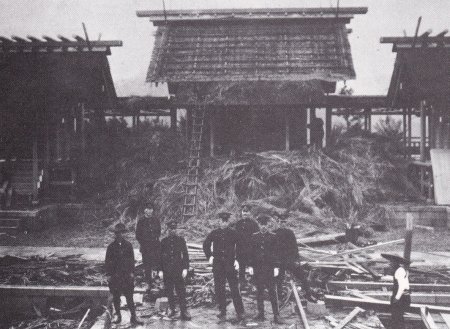 Omoto's brand-new shrine atop Mt. Hongu being demolished by the state authorities in October, Taisho 10 (1921) 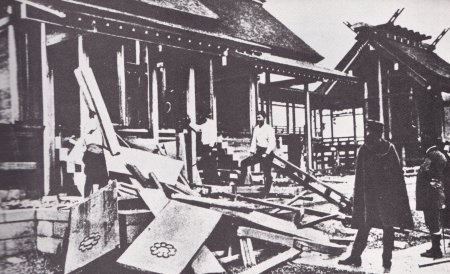 Omoto's brand-new shrine atop Mt. Hongu being demolished by the state authorities (from a different angle) in October, Taisho 10 (1921)  Onisaburo dictating the Reikai Monogatari to a scribe in August, Taisho 14 (1925)  Onisaburo dictating the Reikai Monogatari to a scribe in Ayabe, Kyoto
Interestingly, what Onisaburo dictated on this very date are Chapters 18 thru 22 of Volume 1, which can be summarized as follows:
- There are three major devils on earth that have plunged the world into chaos since its creation: Yamata-no-Orochi , Kimmoh-kyubi Hakumen-no-Akko, and Rokumen-happi-no-Jaki. They are formed as evil thoughts coagulate.
- Yamata-no-Orochi appears in what is known today as Russia, Kimmoh-kyubi Hakumen-no-Akko, in modern-day India, and Rokumen-happi-no-Jaki, in the land of Jews.
- Yamata-no-Orochi possesses the heads of twelve regions of the world and uses them to plunge the world of deities into chaos. Kimmoh-kyubi Hakumen-no-Akko possesses the wives of the regional leaders. Rokumen-happi-no-Jaki plots to vandalize every system of the divine and physical realms so that it can assume the post of the Earth's Ultimate Ruler and disrupt the world into a pandemonium of stray ghosts.
- The Supreme Deity Kunitokotachi of the Earth's divine world is forced to step down due to the evil deities' stratagems.
- When Kunitokotachi is expelled from Jerusalem (in present-day Asia Minor, NOT in Israel) into the Japanese Archipelago, the Creator of the Universe (to be later manifested as Kamususanowo no Ohkami) promises that He will help Kunitokotachi be reinstated as Supreme Leader of the Earth when the time is ripe.
The main scribe was Masaharu Taniguchi, the founder of the Seicho no Ie religious organization, as shown below:
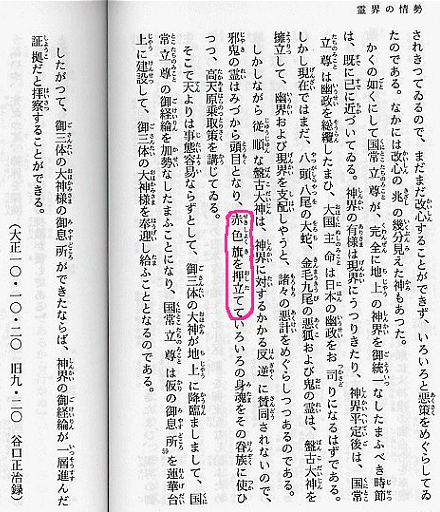 Excerpts from Chapter 18 of Volume 1 of the Reikai Monogatari
(Note)
According to Onisaburo, what happened in the Divine World will happen to Japan and Omoto in a similar fashion (See Dragon-Shaped Japanese Islands).
The passage above says:
- Evil deities are trying to take over the Earth's Taka-Ama-Hara (literally "Heaven", and figuratively "Omoto" in this context) while "marching with a red flag hoisted high" (pink circle in the picture), and
- The Creator of the Universe decides to come to the rescue of the Earth's Supreme Leader Kunitokotachi, and Kunitokotachi welcomes Him at a temporary sanctuary he built for the Great August Deity. (The underline hints at the short life of Omoto's brand-new shrine.)
Red flags are normally associated with the Communists, but the mysteries of the Kirigami Shinji reveal that Emperor Kohmei entrusted the red Imperial Flag (see below) to Kametaro Asahigata, one of his Imperial Palace guards. If the red flag in the passage above alludes to this flag, the authorities' persecution of the Omoto faith was probably carried out under the Emperor's name or possibly under the Emperor's directive. |
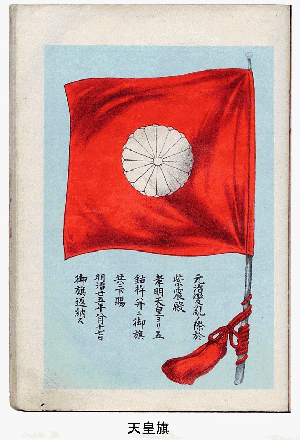 The Imperial Flag entrusted to Asahigata by Emperor Kohmei
Mr. Hisashi Deguchi's research finds that John D. Rockefeller Jr. (1874-1960) and his entourage were in Kyoto on October 20 (by the solar calendar), Taisho 10 (1921) at 1:00 p.m., when the state authorities began demolishing Omoto's brand-new sanctuary, while Onisaburo started dictating the Reikai Monogatari to his scribes.
Both John D. Rockefeller Jr. and Prime Minister Takashi Hara, who gave the order to crack down on Omoto, are rumored to be associated with the U.S. Freemasonry. For this and other reasons, Mr. Hisashi Deguchi suspects that John D. Rockefeller Jr.'s stay in Kyoto was no coincidence, that Prime Minister Hara had financial support from the U.S. Freemasonry, and that there was some U.S. influence working behind the government perscution of Omoto.
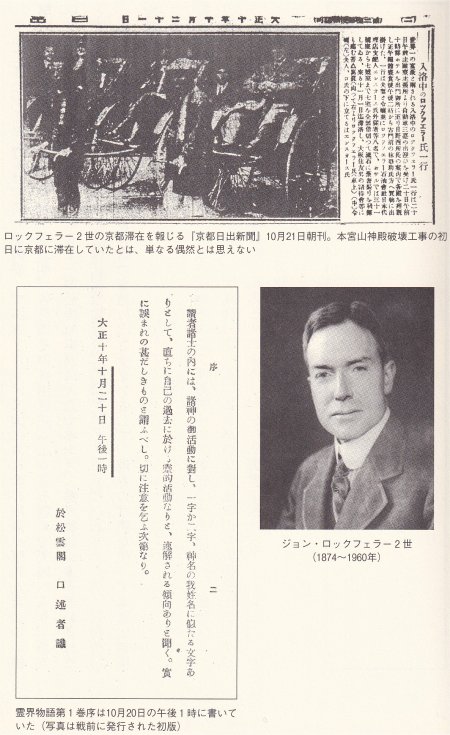 (Upper) An article from a local newspaper in Kyoto, reporting on John D. Rockefeller Jr.'s stay in Kyoto; (Lower Right) A photo of John D. Rockefeller Jr.; and (Lower Left) Excerpts from Volume 1 of the Reikai Monogatari, indicating that they were dictated on October 20, Taisho 10 (1921) at 1 p.m.
(Source: An Unknown History of Japan)
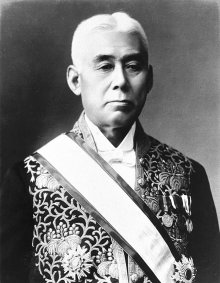 Prime Minister Takashi Hara
On November 4, Taisho 10 (1921), just 15 days after the First Omoto Incident, Prime Minister Hara was shot dead by an assassin at Tokyo Station. The assassin was a man named Kon'ichi Nakaoka with quite an unusual kanji character ushitora ( ), which has the exact opposite meanings of "beginning (= Alpha)" and "end (= Omega)." ), which has the exact opposite meanings of "beginning (= Alpha)" and "end (= Omega)."
The Reikai Monogatari describes the Kami Kunitokotachi no Mikoto (Earth-Eternally-Standing-Deity) as the creator of the Earth's divine world. In the ages of the gods 350,000 years (perhaps a figurative number) back, Kunitokotachi no Mikoto was the supreme leader of the world government in Jerusalem in what is now called Turkey in Asia Mior (not in Israel). He made commandments of heaven and earth with a past incarnation of Moses. However, Kunitokotachi's overly strict observance of the laws touched off a series of rebellions against him by many other deities, resulting in his resignation as chief ruler and his expulsion from the holy city into the Japanese Archepelago. Because the island country was in the northeast of Jerusalem, he was dubbed Ushitora (Northeast)-no (of)-Konjin (God of Retribution, because the rebellious devils were very much afraid of him). This 'ushitora' as in Ushitora no Konjin is the same kanji character  . .
For more about Ushitora no Konjin and John's Revelation, see the following:
Prime Minister Hara hailed from the Village of Motomiya ( ), and his authorities destroyed Omoto's brand-new shrine atop Mt. Hongu ( ), and his authorities destroyed Omoto's brand-new shrine atop Mt. Hongu ( ) - exactly the same kanji characters. Is this a coincidence? ) - exactly the same kanji characters. Is this a coincidence?
Volume 52, Chapter 24 of the Monogatari (dictated on February 10, Taisho 12 (1923) by the solar calendar, or December 25, Taisho 11 (1922) by the lunar calendar) identifies Aritomo Yamagata, a senior Japanese politician and military commander, who was twice elected as Prime Minister, as the mastermind behind the First Omoto Incident, and Prime Minister Hara as his accomplice, as shown in the red box below:
(Note)
- In the passage above, Prime Minister Hara appears as 'Keisuke' while Aritomo Yamagata as 'Kyosuke Katayama.'
- Onisaburo uses indirect references probably on purpose to avoid accusations from the state authorities.
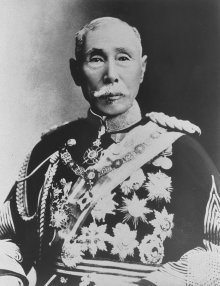 Aritomo Yamagata, whom the Monogatari identifies as the mastermind behind the First Omoto Incident
Onisaburo says that the Reikai Monogatari is a Book of the Last Judgment that establishes and promulgates the eligibility criteria for becoming denizens of heaven or hell, as shown below:
It could be that to forestall the release of this "Book of the Last Judgment," evil spirits in Hell used the Japanese state authorities to destroy the brand-new shrine atop Mt. Hongu on Omoto's holy ground.
Emperor Kohmei and the Kirigami Shinji
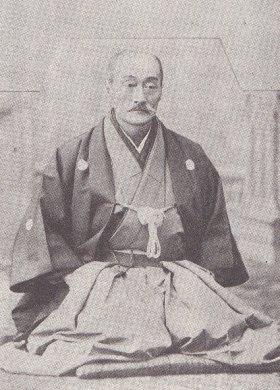 Kametaro Asahigata in his later years A former sumo-wrestler-turned Imperial guard, Asahigata played an important role in founding Asahi Breweries, Ltd.
Let us now focus on Emperor Kohmei's source of the Kirigami Shinji.
The political situation in the reign of Emperor Kohmei (1831-1866) was very unstable. The 1853 arrival of Commodore Matthew Perry and his four warships (dubbed "black ships") of the US East India Squadron at Uraga at the mouth of the Edo Bay opened Pandora's box, undermining the foundation of the Tokugawa Shogunate and polarizing the nation into pro- and anti-Tokugawa camps.
The pro-Tokugawa forces sought to maintain the status quo and often shared common interests with the "respect the Emperor and expel the barbarians (foreigners)" advocates. Since Emperor Kohmei was dead set against foreign influence, he often incurred the wrath of anti-Tokugawa reformists, such as the Choshu (present-day Yamaguchi) and Satsuma (modern-day Kagoshima) domains. (These two domains eventually toppled the Tokugawa Shogunate and established the Meiji government.)
To redeem its political influence, the Choshu domain fought with other domains at the Imperial Palace in Kyoto in 1864. It is called the Kinmon Incident ("Kinmon" refers to a gate of the Imperial Court).
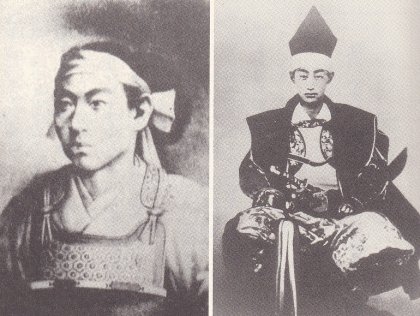 Genzui Kusaka, commander-in-chief of the army of the Choshu Domain (left), and Katamori Matsudaira, lord of the Aizu Domain (right) (Source: An Unknown History of Japan)
The gunfire was so intense that stray bullets crossed the Court, endangering the Imperial Family. The 13-year-old Prince Mutsuhito (= Emperor Meiji) passed out at this dreadful sight, and court ladies and chamberlains turned pale. But the Emperor remained unperturbed. Then came a shout to protect the Emperor.
Kametaro Asahigata, captain of the Imperial Palace Guard, came to the rescue of the Mikado. Given his augustness, however, he dithered over how to rescue Emperor Kohmei. It would be rude of me to hold His Majesty on my back because I'm a lowly commoner, not to mention a greater likelihood of him being exposed to stray bullets. But it would also be rude of me to hold him on my chest and touch his flesh because he is so noble.
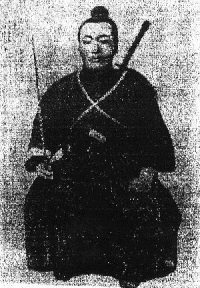 Asahigata as an Imperial guard
All of a sudden, a former sumo wrestler, Asahigata decided to carry the Emperor on his palms. Despite several bullets he suffered in flight, he did a gallant job of rescuing the Suzerain.
Hailing this feat, Emperor Kohmei conferred the following 31-syllable waka poem on the brave guard:
 |
Terukage o
Hirate ni ukeshi
Asahigata
Chiyo ni kagayaku
Isao narikeri |
Translation:
That Asahigata carried the Glittering Light (implying Emperor Kohmei; the Emperor is often likened to a gyoku [gem]) on his palms is a feat that will endure for thousands of years. |
It is at this time that Emperor Kohmei not only taught Asahigata the Kirigami Shinji (Cut-Paper Revelation), or what he called a "secret art of the Divine Nation (Japan)," but also entrusted him with the Emperor's autographs and the Imperial Flag.
 The Imperial Flag entrusted to Asahigata by Emperor Kohmei
Later, two court nobles, Sanenaru Saga and Michitomi Higashikuze, also offered Asahigata the following waka poems:
| Sanenaru Saga | Michitomi Higashikuze |
Ku o wasure
Ie o sutetaru
Joubu ga
Akaki kokoro wa
Kami zo shiruran
Translation:
Kami will understand how much sincerity this daring, self-sacrificing guard exercised in rescuing the Emperor. |
Miyabashira
Futoshiku tatete
Asahigata
Kagayaku Isao
Chiyo mo kuchiseji
Translation:
Asahigata's dazzling feat will be remembered for the next thousands of years. |
Sanenaru Saga is the same as Sanenaru Ogimachisanjo. He convinced Emperor Kohmei to marry his sister Princess Kazu to the 14th Shogun Iemochi of the Tokugawa government for political expediency. This agonized Prince Taruhito (Onisaburo's real father) because she was his fiancee. Aware of the futility of fighting against foreign influence, Saga decided that it would be best for the Imperial Court to become independent of the Shogunate, and he gave Satsuma and Choshu domains a secret order to topple the Tokugawa government.
Incidentally, Volume 41 of the prophetic Reikai Monogatari suggests that Tomomi Iwakura, a court noble who would later become a major architect of the Meiji Restoration, plotted to remove Prince Taruhito of the House of Arisugawa from the Imperial succession by nullifying the Prince's long-time engagement to Princess Kazu, as shown in the red box below:
(Note)
- In the passage above, Tomomi Iwakura appears as 'Minister of the Right Karu-chin,' Prince Taruhito of the House of Arisugawa as 'King Seran,' and Princess Kazu as 'Yasudara-hime,' respectively.
 Tomomi Iwakura (1825-1883)
Michitomi Higashikuze is one of the seven court nobles who sought political asylum with the Choshu domain after expelled from the Imperial Palace in a political tug-of-war between the Satsuma-Aizu alliance and the Choshu domain (In those days Satsuma and Chosu were at odds with each other). As a result, the Satsuma and Aizu domains, which advocated a coalition of the Court and the Shogunate, purged the "respect the Emperor and expel the barbarians (foreigners)" Choshu domain from Kyoto.
That Emperor Kohmei deposited the Imperial Flag with Asahigata, a mere commoner, is unbelievable but this suggests how volatile the political situation around the Mikado may have been. The Tamahoko no Hikari (one of the four booklets found at Mr. Deguchi's residence) reports what the Emperor told Asahigata when he entrusted the red Imperial Flag to his bodyguard:
"Twenty-eight years from now, in the year of the dragon, the Great Maitreya Deity will become manifest. With this August Deity, our Imperial Nation will be all right. But till then, great upheavals will break out here and there. Therefore, I will deposit this flag with you until the Deity's manifestation. When the year comes, choose an appropriate date to return the flag."
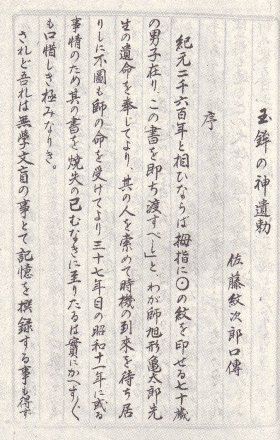 Preface of the Tamahoko no Hikari by Monjiro Sato
For details about the booklet and accompanying numerical table, see:
This Imperial Flag was safely returned to Emperor Meiji on August 17, Meiji 25 (1892). As a token of his appreciation, the Emperor gave Asahigata 100 yen (a hefty sum in those days) through the Imperial Household Ministry:
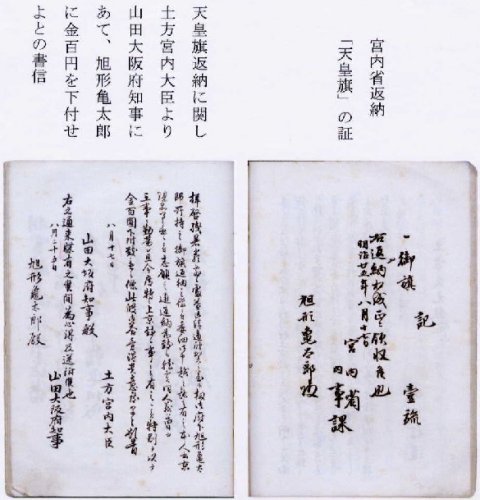
A document (left) indicating the receipt of the Imperial Flag from Asahigata by the Imperial Household Ministry, as well as a directive (right) in which Minister Tsuchikata of the Imperial Household instructs Governor Yamada of Osaka Prefecture to bestow 100 yen on Asahigata in appreciation for the return of the Imperial Flag |
Since the Imperial Flag is a must item for succession to the Imperial Throne, the question may arise here: How did Emperor Meiji accede to the Chrysanthemum Throne without the Flag?
Monjiro Sato (to be detailed later), Asahigata's disciple, had the same question, and one of his friends, Kagenori Shinohara, happened to be acquainted with a retired member of the Shimazu family who ruled the Satsuma domain. This domain was a major architect of the Meiji government.
This old man said that people concerned were so troubled by the lost Flag that they had another Imperial Flag woven with the brocade they had bought at 100 yen (a hefty sum in those days) in the Nishijin district of Kyoto. His remark proves what Emperor Kohmei had entrusted Asahigata with was the genuine Imperial Flag.
A while later, upon this retired Shimazu's request, Sato and Shinohara revisited his mansion. Sato told him about Emperor Kohmei's Kirigami Shinji, its revelations and numeric charts, and he was deeply impressed. When Sato mentioned Omoto, however, he got furious and began lashing out at Sato. (Note: Omoto, newly organized around this time, was often mistreated as a dangerous cult.) Unable to bear the vile epithets, Sato left the mansion.
After this incident, Jinsai Yuasa, a senior member of Omoto, visited Sato and suggested that he have the old man write a note of confirmation that the loss of the Imperial Flag resulted in the use of a makeshift substitute during Emperor Meiji's enthronement ceremony.
Sato visited Shinohara to inform him of Yuasa's suggestion. Then came Shinohara's surprising news: The retired Shimazu dropped dead shortly after he swore at Sato. This reminded Sato of what Emperor Kohmei had revealed in his autographs and the Kirigami Shinji:
Anyone who would oppose this is a traitor and cannot be allowed to stay on the divine ground of Japan.
Historically, Emperor Kohmei (1831-1866) was perceived as an obstinate figure who clung to the idea of expelling foreign influence from Japan. For this reason, he begrudgingly nullified Prince Taruhito's long-time engagement to Princess Kazu, the Emperor's half-sister, to strengthen ties between the Imperial Court and the Tokugawa Shogunate by agreeing to marry Princess Kazu to the 14th Shogun Iemochi Tokugawa as his lawful wife.
(Volume 41 of the Reikai Monogatari suggests that this Imperial decision was based on Tomomi Iwakura's advice. See above)
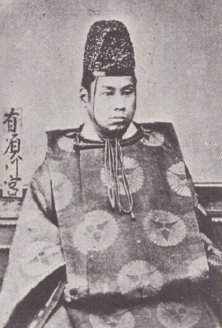 Prince Taruhito of House of Arisugawa
 Princess Kazu
 14th Shogun Iemochi Tokugawa
Having lost his fiancee, Prince Taruhito met 19-year-old Yone Ueda at a riverside inn in Meiji 1 (1868). Partly to console himself, and partly because he was attracted to her, the prince frequented this hotel to have an affair with Yone, with the culmination in the birth of Onisaburo Deguchi (original name: Kisaburo Ueda).
For details, see Prince Arisugawa's Tanzaku
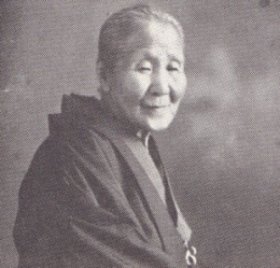 Yone Ueda, Onisaburo's mother, in later years
The Tamahoko no Hikari indicates that Emperor Kohmei knew through the Kirgami Shinji that the United States would plot to invade Japan in the future. His adamant refusal to give in to foreign influence probably came from his conviction about this prophesied Japan-US war 80 years later.
The prophecies of the Kirigami Shinji
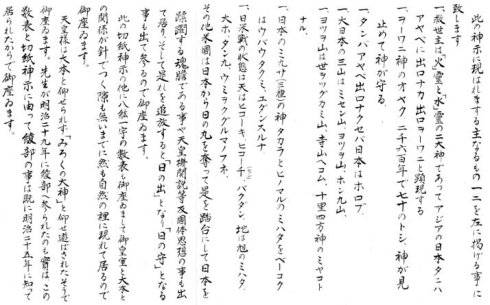 The Prophecies of the Kirigami Shinji
Emperor Kohmei taught Asahigata the following prophecies based on the revelations of the Kirigami Shinji:
| (1) |
The saviours will be the two great deities (i.e. the "fire" spirit, and the "water" spirit), manifesting themselves as Naka Deguchi (= Foundress Nao) and Oh-wani Deguchi (= Onisaburo) in Ayabe, Taniha (= northwest of Kyoto), the Asian country of Japan.
(Note: "fire" [ka] and "water" [mi ] = kami. In Shinto, fire and water often represent the Kami.)
|
| (2) | The Kami will watch and protect the divine role of Oh-wani, who will turn 70 years old in the Imperial Year 2600 (= Showa 15 [1940]) . |
| (3) | Japan will perish without the Deguchis in Ayabe, Tamba (= Taniha). |
| (4) | The three most important mountains for the Greater Japan are Mt. Misen, Mt. Yotsuwo, and Mt. Hongu.
(Note: These three mountains are all in the Tamba region. Mt. Hongu is where Omoto's holy of holies is. Mt. Yotsuwo, located near Mt. Hongu, is believed to enshrine the spirit of Kunitokotachi no Mikoto.)
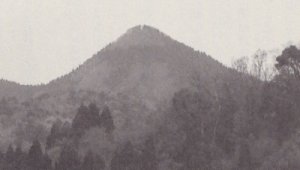 Mt. Misen (664 m), where Foundress Nao hid herself for a week to perform the iwato-gomori(holing up in a cave and sealing its entrance door) mission. 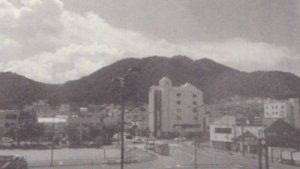 Mt. Yotsuwo (287 m), an icon of Ayabe City. As the name Yotsuwo (four peaks) suggests, you can see the four peaks of the mountain. 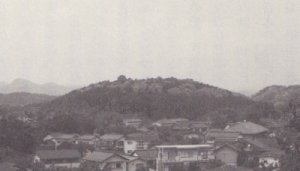 Mt. Hongu (92 m), Omoto's holy of holies (Source: An Unknown History of Japan) |
| (5) | Mt. Yotsuwo is a sacred mountain to succeed the world. Mt. Tera will submerge. A 10-square-ri (= 244-square-mile) area (surrounding Mt. Hongu) will be the Kami's sanctuary.
(Note: The number should be a figurative expression for a large area.)
|
| (6) | Beware that the United States plans to rob Japan of the three regalias of the Imperial Throne and the Rising-Sun Flag. |
| (7) | When war breaks out between the United States and Japan, warplanes, airships, and bombs will cover the sky while the Rising-Sun flags, canons, tanks, and undersea evil ships (= submarines) will dominate the earth. |
Perhaps sensing his imminent death, Emperor Kohmei revealed these prophecies to Asahigata, a mere bodyguard. This is probably because there was really no one around whom the Emperor could confide to.
In fact, the Emperor died suddenly, and some insist that he was assassinated by anti-Shogunate forces. Even in those days, there was a rumor circulating that the Empeor might have been poisoned.
The following books argue that Hirobumi Ito, Tomomi Iwakura and other anti-Shogunate forces assassinated the recalcitrant Emperor Kohmei as he worked with the Tokugawa Shogunate to expel foreign influence, and that the anti-Shogunate forces replaced the genuine Prince Mutsuhito (in the Northern Court line) with Toranosuke Ohmuro, an alleged descendant of the Southern Court line, who would eventually become Emperor Meiji.
Interestingly, An Jung-geun, the Korean who killed Hirobumi Itoh, Japan's first prime minister, accused Itoh of having assassinated Emperor Kohmei as a motive for his gunning down the low-ranking samurai-turned architect of the Meiji government.
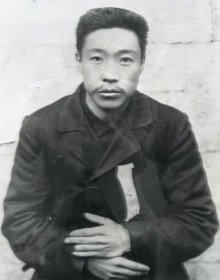 An Jung-geun
 Hirobumi Itoh
Here the question arises: Why did the Emperor choose not his close aides, not even his son Prince Mutsuhito, but Asahigata, of all people? In The Tamahoko no Hikari, Monjiro Sato speculates how it happened to his master, saying that many court nobles of the time treated the bigoted Emperor like a madman, and that the Emperor virtually had no one to turn to. (Anyone would see the Mikado as crazy if he acted on the Kirigami Shinji revelations, especially the vision of the US-Japan War that would materialize 80 years after his death.)
Another theory might be that the Mikado was somehow aware - spiritually, intuitively or otherwise - of the alleged assassination of Prince Mutsuhito and the ensuing usurpation of the Chrysanthemum Throne by Toranosuke Ohmuro and his loyalists.
Surprisingly, the prince's appearances and behavior differ significantly between before and after his enthronement as Emperor Meiji:
Prince Mutsuhito
(before enthronement)

What is believed to be the
real Prince Mutsuhito |
Prince Mutsuhito
(after enthronement)

What we are led to believe
as Emperor Meiji |
| He had no pockmarks in his face. |
He was pitted with smallpox. |
During the Kin-mon Incident, the 13-year-old prince lost consciousness at the sound of gunfire and the scream of his court ladies.
♣The Kin-mon Incident: In 1864, pro-Imperial Choshu domain extremists attempted to force their way into the Imperial Court in central Kyoto, and the Imperial Court ordered the Tokugawa Shogunate to mount a punitive expedition against Choshu. |
Riding a horse gallantly, he inspected his Konoe
Imperial Guards and shouted a command. |
| He was born weak and caught cold every year. Even at age 16, he still played with his court ladies. |
The 198-pound giant had sumo bouts with his aides and threw them out of the ring. |
| His handwriting was illegible, and he was indifferent to politics. |
He wrote quite neatly, and he was a well-educated, highly-motivated learner. |
| He could not ride a horse. |
He rode a horse to inspect his troops at a parade during the Battle of Toba-Fushimi.
♣The Battle of Toba-Fushimi: In 1868, Tokugawa soldiers fought with the federation of Satsuma and Choshu domains in Toba and Fushimi, Kyoto. It escalated into the Boshin Civil War of 1868-69, where Shogunate loyalist forces were defeated in a series of battles. |
Mitsuaki Tanaka, a close aide to Emperor Meiji, was quoted as saying that Emperor Meiji was not Prince Mutsuhito, the son of Emperor Kohmei (both of whom came from the Northern Court), and that Prince Mutsuhito was assassinated and replaced by Toranosuke Ohmuro, presumably a descendant of the Southern Court.
The following is a photo of what is believed to be Toranosuke Ohmuro (No. 40), along with Guido Verbeck (No. 30), Takamori Saigoh (No. 13), Hirobumi Itoh (No. 9), Ryohma Sakamoto (No. 43) and other loyalists from such domains as Choshu, Satsuma, and Tosa:
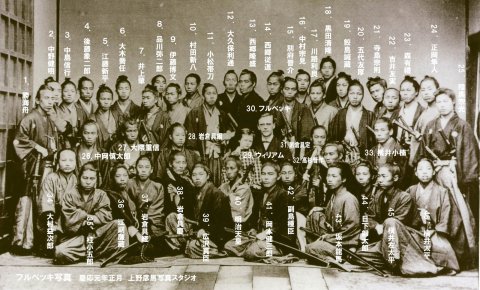 Guido Verbeck (No. 30) and Toranosuke Ohmuro (No. 40), surrounded by loyalists from Choshu, Satsuma, Tosa and other domains
The authenticity of this photo has been under heated debate as some people claim it as a fake.
Guido Verbeck, Ernest Satow, Thomas Blake Glover are alleged Freemasons, and they apparently assisted those young samurai in the photo in toppling the Tokugawa Shogunate. Many of those samurai later became major architects of the new Meiji government, with the culmination in the accession of Toranosuke Ohmuro to the Chrysanthemum Throne.
What is historically termed the Meiji Restoration of 1868 can be called the "Freemasonry Revolution" or "Southern Court Revolution."
Renowned for his prophetic ability (over 90 percent accuracy), Onisaburo secretly embedded a message in a dozen of 12-syllable poems for Omoto's missionary work (see below) to the effect that the Emperor was an imposter.
 |
The 4th highlighted row (right to left) says: "Ayabe ni tenshi wo kakuseri " (The true emperor is hidden in Ayabe)
The 8th highlighted row (left to right) says: "Imano tenshi nisemono nari " (The current emperor is a false one)
|
Onisaburo had to use this method because in those days the Emperor was deified as an inviolable being, and any open criticism of him would trigger punishment for a charge of lese majeste.
By "Ayabe ni tenshi wo kakuseri " (The true emperor is hidden in Ayabe), Onisaburo hints that he IS the true emperor. Please note that he is not a megalomanic nor does he let his imagination run wild. His message is based on the truth. Onisaburo is an illegitimate son of Prince Taruhito of the House of Arisugawa. Prince Taruhito was first in line to the imperial throne until Prince Yoshihito (= Emperor Taisho in the future) was born, and since Prince Taruhito had no children, Onisaburo could have been appointed emperor.
 Prince Taruhito, the biological father of Onisaburo
There are also some passages in the Reikai Monogatari that hint at the possibility of the false Emperor. Volume 67, Chapter 6 is a case in point. First, its full text is shown below. Then, its underlying messages and related details are provided.
Summary:
- The towering rock mountain on the floating island used to be revered by the public as a holy site for centuries. Atop the mountain is a hugh rock that used to emit bright light like the Sun or Moon, serving as a lighthouse or guiding star for ships navigating at moonless nights.
➡ The "towering rock mountain" symbolizes the long reign of the Japanese imperial family (126 monarchs and counting since 660 BC).
➡ A "huge rock" implies the Emperor and Empress on the throne.
- A strong wind blowing from the west has caused the floating island to be moving eastwards.
➡ Culturally, a "strong wind blowing from the west" suggests the rapid Westernization of Japan during the Meiji era since U.S. Navy Commodore Matthew Perry led a fleet of black ships to the Tokyo Bay in1853 to force the long-secluded insular country to open its doors to the outside world.
➡ From a perspective of the Japanese imperial history, a "strong wind blowing from the west has caused the floating island to be moving eastwards" implies the transfer of the Japanese capital from Kyoto (the seat of the Imperial Palace) in western Japan to Tokyo (the former Edo Castle-turned Imperial Palace) in eastern Japan in 1868, when the new imperial era 'Meiji' began and the Emperor Meiji came to Tokyo.
➡ Some people think that the Emperor Meiji (= an impostor named Toranosuke Ohmuro) "fled to Tokyo" to conceal his true identity because imperial princes/princesses and other court nobles in Kyoto, who knew the true Prince Mutsuhito, would easily unmask Toranosuke Ohmuro posing as Prince Mutsuhito (= Emperor Meiji).
- The huge rock on the mountain is called the Akeharu no Iwa (Akeharu Rock). It used to be respected by the public as a guardian of the country, but now it has lost its shine and can collapse at any moment with a large crack running through it. As a result, it has been nicknamed the 'Big Black Rock'.
➡ Akeharu as in the Akeharu Rock can be converted to the kanji characters  , which can also be read as "Meiji." This drops a heavy hint that contextualizes the whole passage. , which can also be read as "Meiji." This drops a heavy hint that contextualizes the whole passage.
➡ The Meiji government forced through the deification of the Emperor by taking various steps, such as the promulgation of the Constitution of the Empire of Japan, or loosely termed the Meiji Constitution of 1889. Any criticism of the Emperor, orally or in writing, could have jeopardized critics' life. What the Constitution calls "Japanese subjects" were muzzled by the imperial Japanese government in the name of the "sacred and inviolable" Emperor.
➡ Japanese subjects grew dissatisfied with the emperor system, as symbolized by "now it has lost its shine and can collapse at any moment with a large crack running through it." That was why some called the Emperor names - behind his back, of course.
➡ The "Big Black Rock" seems related to Oh Kuro-nushi (Great Black Master) of the Brahman faith in Haruna (present-day Mumbai), India.
In the Reikai Monotarari, believers of the Ananai faith are righteous deities who devote themselves to creating the Age of the Maitreya Kami in heaven and on earth. They make special squads to reform evil deities with kototama (a belief that sacred power dwells in spoken words). A whopping 30-plus volumes (Vol. 39 through 72) out of 81 are devoted to describe how hard those kototama squads, as dispatched on the Great Kami Kamususanowo's orders, work to reform the leader Oh Kuro-nushi of the Brahman faith in Haruna (present-day Mumbai), India with kototama.
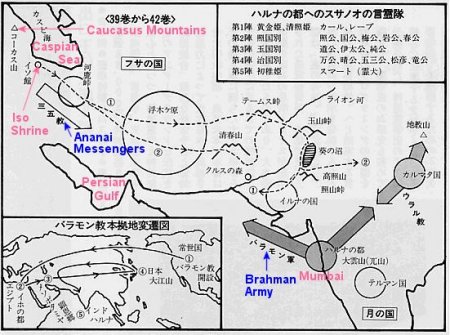 Map of Kamususanowo vs Oh Kuro-nushi Map of Kamususanowo vs Oh Kuro-nushiBy courtesy of Hachiman ShotenDivine messengers of the Ananai faith are dispached to Mumbai from Kamususanowo's Iso Shrine in the Caucasus Mountains, and along the way they try to lead the Brahman army into the right path with kototama (divine words)
The Great Black Master, whose real name is Onikumo-hiko (Ogre Cloud Prince), controls deities across the world with power, ideology and authority. As the "Big Black Rock" implies, the Emperor or emperor system was probably influenced by Oh Kuro-nushi or similar to his way of domination.
- The rock mountain used to be holy ground, with occasional descents of the Sun and Moon Deities from heaven to use eight million divinities to purify the atmosphere and provide rest and quiet for all creation. But now it has been inhabited by weird monsters, beasts and other creatures.
➡ The above suggests widespread corruption of the emperor system and the resultant loss of divine protection. After all, Emperor Meiji was an impostor, a false one, and the Meiji government wanted to use his inviolable authority to rule the nation to the extent of making Japanese subjects worship him as a living god. This probably incurred the wrath of the True Kami, forcing the Emperor to deny his divinity upon Japan's defeat in World War II.
- People have stayed away from this island because of the rumor that anyone setting foot on there would fall prey to ferocious monsters, with their blood sucked, their flesh eaten, their bones burned, and their life cut short. People even call the island the 'Devil's Island'. But they cannot say it openly because monsters will do them harm once they get wind of it. They simply remain silent about the Big Black Rock to ensure their safety.
➡ There was virtually no freedom of speech or the press when it came to issues on the Emperor or emperor system. Lese-majeste, a crime against the Emperor or the imperial family, was applied and special political police (i.e. secret police) were deployed across the country to silence critics or opponents. The Imperial Rescript on Education of 1890, the Emperor's view on education for Japanese subjects, was forcibly instilled into the people at school and educational institutions, laying the foundation for the rise of nationalism in Japan.
- The Big Black Rock starts to wobble as the whole floating island shakes. What looks like the big rock is actually a pair of big tigers, and they descend the rock mountain. People aboard a ship approach the island and find that what looks like the pair of big tigers from a distance is actually a pair of cow-like tiger cats. Those cats glare at the ship as they run away westwards with their tails between their legs. Soon the whole island rumbles and quakes with the mountain crumbling away before it sinks into the sea.
➡ As the above item implies, the emperor system crumbled with Japan's defeat in World War II, culminating in the relegation of the Emperor to a symbol of the Japanese nation. What looked like a living god actually turned out to be a "big tiger." This drops yet another heavy hint and can be prophetic because the name of Toranosuke Ohmuro posing as Emperor Meiji contains two kanji characters that signify a "big tiger," as shown below:
- Ume-koh, a believer and propagandist of the Ananai faith goes up on the deck of the ship after having lied on the bottom. He talks with some other passengers and says that mysterious things like the sinking of the island are occurring in many places and will occur going forward because the whole world has become corrupt with the good being downtrodden and the bad flourishing and usurping national politics.
➡ Propagandist Ume-koh is on his way to Haruna (present-day Mumbai), India under the Great Kami Kamususanowo's orders to reform the leader Oh Kuro-nushi of the Brahman faith with kototama.
➡ "Ume-koh ... goes up on the deck of the ship after having lied on the bottom" suggests the government crackdown on Omoto in Showa 10 (1935) and the ensuing imprisonment of Onisaburo and his senior believers. On August 7, Showa 17 (1942), as Ume-koh "goes up on the deck," Onisaburo returned to his Kumano Residence in Kameoka, Kyoto after he was released on bail. In other words, Onisaburo had been in jail for 2435 days, or 6 years and 8 months.
- Ume-koh goes on to say that we should brace ourselves for even severer trials and tribulations, such as major global wars, religious conflicts between believers of the Ural faith and those of the Brahman faith, and horrible scourges around the world. Therefore, Ume-koh and other Ananai propagandists are committed to disseminating the teachings of the Great Kami filled with the virtues of love and goodness and the light of truth and trust so that He can save all His creation.
➡ The Reikai Monogatari says that the Ural faith has its roots in the Ural region, Russia, and that the Brahman faith was founded on the Rocky Mountains in the present-day United States. Thus, "religious conflicts between believers of the Ural faith and those of the Brahman faith" may have predicted the Cold War between the Western Bloc (the United States and its allies) and the Eastrn Bloc (the Soviet Union and its allies).
- Ume-koh cites the following verities "Divine Power and Human Power" as teachings of the Ananai faith:
- The original source of the universe is vital energy, i.e. the Kami.
- All things are manifestations of this vital energy, hence fragments of the Kami.
- Humans are primary agents for the Kami and are entrusted with responsibilities for leading, propagating and supervising the Divine Work for heaven and earth. This vital energy is infinite and boundless and is therefore the source of religion, politics, philosophy, ethics, education, science, law, and other fields.
- Humans are children of the Kami, and living shrines of the Kami. In addition, they can grow up to be gods by themselves.
- Since humans are children of the Kami, they should follow His examples, work energetically, trust themselves, trust others, but never rely on others too much.
- Humans deserve to be called "gods" if they work for the peace and happiness of the world and mankind in the face of adversity, and take action for the truth and achieve intended results.
- The Kami is the all-pervading vital spirit of the universe, and humans are primary agents for the Divne Work. When spirit and body become one, it will exhibit infinite and boundless authority, laying the foundation for eternal existence.
➡ Onisaburo preaches the way of man under the True Kami ubiquitous in the universe, NOT under man-made and political religions like State Shinto.
➡ On Decemeber 8, Showa 20 (1945), Onisaburo started a new religious group named the Aizen-en (literally "Garden of Love and Goodness") by totally renewing the outdated Omoto religion to create good kata models for Japan and the world in the future. He adopted the verities "Divine Power and Human Power" above as guiding principles for the Aizen-en.
➡ The Osaka Asahi Daily carried an interview with Onisaburo on December 30, Showa 20 (1945). In it he says to the effect that:
- Forgetting the True Existence, and conveniently idolizing only specific Shinto shirines and imposing them on the people has caused Japan to take the wrong path, and
- It has been fundamentally wrong for State Shinto shirnes in Japan to enshrine and worship not gods, but mere humans.
Two days after what was later known as Onisaburo's "Yoshioka Declaration," Emperor Hirohito declared that he was not a living god, and that the concept of the Emperor's divinity was not true, in the Imperial Rescript Denying His Divinity (Professing His Humanity) released on January 1, Showa 21 (1946).
- Hearing Ume-hiko describe "Divine Power and Human Power," Iruku, a merchant at the Port of Suga who is disillusioned with existing religions including his family's Ural faith, is so impressed by the teachings of the Ananai faith that he offers to invite Ume-hiko to his home, whose invitation Ume-hiko readily accepts.
➡ According to the Reikai Monogatari, the Ural faith upholds self-centered rationalism.
Though a lowly guard, Asahigata is presumed to have played a uniquely important role in the liaison between court nobles and anti-Shogunate reformers. The Asahigata Shoden (one of the four booklets found at Mr. Deguchi's residence) reports that he was acquainted with such noted revolutionaries as Takamori Saigo, Yoshitaka Kido, Masujiroh Ohmura, Toshimichi Ohkubo, and Ryohma Sakamoto. Also conceivable is his association with Prince Taruhito of the imperial house of Arisugawa because the prince himself was proactive in finding ways to topple the Tokugawa regime and in the process knew those Meiji revolutionaries. A framed calligraphy by Prince Taruhito hangs at the shrine Asahigata built for the late Emperor Komei.
Emperor Kohmei's posthumous edict
Besides providing Asahigata with the Kirigami Shinji and its prophetic messages, Emperor Kohmei asked him to carry out the next orders:
When the year turns to 2600 by the imperial calendar (= Showa 15 [A.D. 1940]), the United States will plot to seize the Japanese Flag and three regalia of the Imperial Family, and will definitely invade the island nation in the future.
When the United States invades Japan, it will plan to usurp the divine mirror at the Grand Shrines of Ise, the divine sword at Atsuta Shrine, and the divine jewel (Chrysanthemum Throne). Therefore, I ask you to enshrine my soul in the land of Taketoyo located midway between Ise and Atsuta upon my death so I can protect the Imperial Nation (Japan).
This Asahigata lived by with all his heart, mind and strength. He had to go through countless twists and turns before he finally made it. How he got to build a shrine dedicated to the demised emperor will be detailed later.
Now let us take a look at how Asahigata met his disciple, Monjiro Saito.
Monjiro Sato
The Tamahoko no Hikari says that Monjiro Sato was born into a rice farming family near Nagoya, Aichi Prefecture on March 9, Meiji 1 (1868). That year was the "year of dragon" according to the Chinese zodiac. After finishing the military draft test, Monjiro visited an acquaintance in Nagoya and began working at a rickshaw firm. He later came to the fore as the most powerful rickshaw man.
In the spring of Meiji 24 (1891), Monjiro and another rickshaw man sent their customers to Nagoya Station, when three people got off the train and asked them for a ride. The customers wanted to go to a sumo stable master's residence. The strongest Monjiro decided to carry the largest sumo-wrestler-looking man. He was Kametaro Asahigata. This is how fate had them meet.
Since then Asahigata had always asked for Monjiro whenever he went to and from the stable master's residence, showing affection to the rickshaw man by calling him "Sato-san." One day, Asahigata asked Monjiro how old he was, and Monjiro said he was born in the year of the dragon. For some reason, this prompted the sumo wrestler to beg the rickshaw man to become his disciple. Monjiro eventually became Asahigata's disciple.
In the Tamahoko no Hikari, Monjiro confessed that under Asahigata's tutelage, his philosophy of life transformed from the one where the most important thing was money and the second most important thing was also money into the one where the most important thing was the Emperor and the second most important thing was his country. He added that this happened in Meiji 24 (1891).
One day in Meiji 25 (1892), the year of the dragon, Asahigata put a sheet of Japanese writing paper and a pair of scissors in front of Monjiro at the stable master's residence, straightened up in a solemn posture, and told his disciple as follows:
"Today I'm going to teach you the divine art of the Imperial Nation, which the former Emperor Kohmei taught a humble subject like me. I ask you to learn it with due respect. When teaching me this divine art, the Emperor said the following:
'No one else but I can perform this divine art. Focus on learning this art and forget about the Kami or the Emperor. Sometimes we say tsuru no hitokoe (One's word is law), and it refers to this divine art.'
I received the Emperor's tutorial with the utmost deference. As such, when you perform this divine art, never do it directly on the tatami mat floor under any circumstances. Keep this in mind."
Monjiro received the divine art with humility, but it was filled with so many wonders that he told his master he would not be able to learn all of them. Asahigata quickly assured Monjiro that he would assist his disciple in any way possible. Since then Asahigata would often teach Monjiro the Kirigami Shinji whenever he had the chance. By the time Monjiro had Goro Yoshida (an Omoto believer) dictate the Tamahoko no Hikari because he was illiterate, the rickshaw man-turned successor had performed this art for 52 years. The booklet was proofread by Jinsai Yuasa, also a senior Omoto member.
As described above, Emperor Kohmei said, "No one else but I can perform this divine art." This suggests that anyone can simply arrange the nine cut pieces, but that no one (except the Emperor) can get divine messages from them. Emperor Kohmei was probably able to communicate with the Kami and receive inspiration from Him.
The term "emperor" could be an inaccurate translation of the Japanese equivalent "sumera-mikoto" or "tennoh" because Japanese emperors have originally been shaman-like religious figures. In fact, the Imperial Family performs a variety of Shinto rituals and festivals all year around.
In this connection, Onisaburo says in his Onisaburo to Seinen Zadankai (Youth Members' Round-Table Talks with Onisaburo), a compilation of stories based on dialogues and interactions between young believers and Onisaburo from May, Showa 6 (1931) to August, Showa 8 (1933), that the Yamato race, who is believed to have established Japan's earliest unified state in present-day Nara by A.D. 350, came from around Jerusalem in Palestine or from around Asia Minor. For details, see below:
Tribulations of Founding a Shrine for the Beloved Emperor
When the year turns to 2600 by the imperial calendar (= Showa 15 [A.D. 1940]), the United States will plot to seize the Japanese Flag and three regalia of the Imperial Family, and will definitely invade the island nation in the future.
When the United States invades Japan, it will plan to usurp the divine mirror at the Grand Shrines of Ise, the divine sword at Atsuta Shrine, and the divine jewel (Chrysanthemum Throne). Therefore, I ask you to enshrine my soul in the land of Taketoyo located midway between Ise and Atsuta upon my death so I can protect the Imperial Nation (Japan).
As mentioned earlier, this is the command that Emperor Kohmei asked Asahigata to obey. Surprisingly, the Emperor predicted the US-Japan war, which would materialize some 75 years after his death!
Here a question arises as to why the Emperor chose a lowly commoner like Asahigata to give the bodyguard his all-important posthumous command. In those days, Emperor Kohmei supported the "Revere the Emperor and Expel the Barbarians (= foreign influence)" policy so adamantly - probably based on his Kirigami Shinji prophecy about the US-Japan war in the future - that all court nobles, government officials and others strongly suspected the Emperor's complete insanity. It is therefore no exaggeration to say that the Emperor trusted no one whole-heartedly but only Asahigata. Sato wrote that he remembered tears welling up in Asahigata's eyes whenever his master touched on the Emperor's passionate yet misunderstood sincerity.
To carry out Emperor Kohmei's orders, Asahigata had tried for years to obtain permission to build a shrine dedicated to the Emperor in Taketoyo, Aichi Prefecture, but to no avail. The then-Governor of Aichi Prefecture joined him in his efforts, but again, no permission was granted. In Meiji 28 (1895), Asahigata even moved to Taketoyo to drive up his campaign, but again and again, he did not succeed.
Why was no permission granted to build a shrine for the ill-fated Emperor despite the backing of Aichi Governor? By contrast, Meiji Shrine (dedicated for Emperor Meiji and Empress Dowager Shohken) was built in Taisho 4 (1915), just three years after Emperor Meiji's death. This begs the question of whether there might have been anyone behind it who would not have been happy to see the shrine founded.
Hirobumi Ito (see above), Tomomi Iwakura (see above) and other architects of the Meiji government could haven been behind the non-approval. As mentioned earlier, there was a rumor circulating back then that the Empeor might have been poisoned. Some books maintain that Tomomi Iwakura and other anti-Shogunate forces assassinated the recalcitrant Emperor Kohmei as he worked with the Tokugawa Shogunate to expel foreign influence. Even An Jung-geun (see above), the Korean who killed Hirobumi Itoh, accused Itoh of having assassinated Emperor Kohmei as a motive for his gunning down the low-ranking samurai-turned first prime minister of Japan.
Suppose these senior Meiji politicians had been the assasins of Emperor Kohmei, would they have approved the founding of a shrine dedicated to the emperor whom they killed?
Tomomi Iwakura died in Meiji 16 (1883), and Hirobumi Ito's political clout began to eclipse, as highlighted by the short life of his third cabinet that was formed in Meiji 31 (1898). Only after then at last - 33 years after the demise of Emperor Kohmei - was permission granted to Sato for the construction of the shrine.
Incidentally, Empress Dowager Shohken was the wife of Emperor Meiji, not his mother. Some people believe that she preferred to call herself this way, knowing that his husband was different from the Prince Mutsuhito she had known. In fact, historical documents suggest that she maintained a callous and aloof relationship with her husband Emperor Meiji.
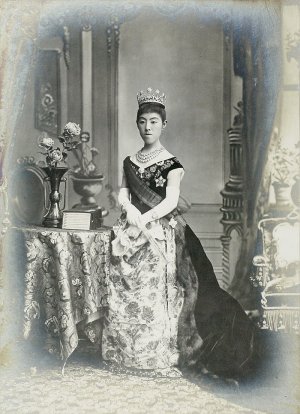 Emperor Dowager Shohken (1849-1914)
Emperor Kohmei's last wish was that his soul would be enshrined in the land of Taketoyo located midway between the Grand Shrines of Ise and Atsuta Shrine so he could protect the Imperial Nation (Japan) from an attack by the United States.
Taketoyo, to which Asahigata moved from Osaka to fulfill the Emperor's last wish, is located as follows:
 Taketoyo stands almost in the middle of Atsuta Shrine and Grand Shrines of Ise. A link of these spots creates an obtuse angle with Taketoyo as its vertex.
The place name "Taketoyo" was born in Meiji 11 (1878) following the consolidation of Nagao Village and Oh-ashi Village. Therefore, when Emperor Kohmei was alive, there was no such village as Taketoyo. The Emperor must have had a divine inspiration about the place name through the Kirigami Shiji; he prophesied the emergence of Taketoyo.
Asahigata bought the land for Tamahoko Shrine in Taketoyo, but the project to build this shrine faced great hardship because the authorities had refused to give permission for over three decades! Asahigata even moved to Taketoyo from Osaka in Meiji 28 (1895) in a desperate bid to make his project successful, but to no avail.
With all his options exhausted, Asahigata went to Ayabe, Kyoto in Meiji 29 (1896) to seek the guidance of the "Great Maitreya Kami."
Asahigata's Encounter with Foundress Nao Deguchi
Sato's Tamahoko no Hikari quoted Asahigata as saying that he had no other choice but to visit the "Great Maitreya Kami" in Ayabe, Tamba for guidance as no permission was granted to build a shrine for Emperor Kohmei.
For details about the Tamahoko no Hikari and its accompanying numerical table, see:
In Meiji 29 (1896), Asahigata and Sato walked towards Ayabe. When they came to the Suchiyama path near their destination, Asahigata said, "A holy shrine will be built on this path, so it needs to be clean." Sato had no idea what his master was talking about, and he simply followed him over the path to knock on the door of the "Great Maitreya Kami" in Ayabe.
Hearing the phrase "Great Maitreya Kami," Sato had imagined that there would be an impressive shrine, but what he actually saw was a small shabby storehouse of about six tatami-mat size (around 10 square meters). When they went into the house, there was only one elderly woman there.
Despite the poor condition of the place, Asahigata prostrated himself to her with deference.
"You are the Great Maitreya Kami," Asahigata said. "I earnestly request that you confer a divine title on the late Emperor Kohmei."
"I'm not the one you're looking for," she said. "I'm never such a noble being. Please visit somewhere else."
The elderly woman declined firmly, but Sato sensed an inexplicably extraordinary air of dignity and kindness she was exuding. No matter how firmly she declined, Asahigata would not budge an inch and made that plea with all his heart.
Eventually, she gave in and said that she would ask the Kami for it. She moved forward to the humble makeshift altar and worshipped. After a while, she turned around to Asahigata, saying, "The Kami says 'Tamahoko no kami ' (The August Deity Tamahoko)."
Asahigata, who usually remained calm and collected under any circumstances, could not contain his excitement or joy on this particular occasion. He thanked her over and over again and headed back home with great delight.
Sato identified this elderly woman, who conferred the divine name on the late Emperor Kohmei, as Nao Deguchi (Foundress of the Omoto faith).
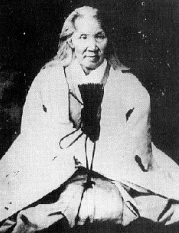 Foundress Nao Deguchi (1837-1919)
In the New Year peoriod of Meiji 25 (1892) by the lunar calendar, Kunitokotachi no Mikoto (dubbed "Ushitora no Konjin") possessed Nao Deguchi. Four years later, Asahigata and Sato met with Nao in Ayabe. In those days Nao just started her religious activities with a small following of her believers, and it took her another two years to join forces with Onisaburo Deguchi in Meiji 31 (1898). Therefore, Nao was probably very much unknown when Asahigata and Sato visited her. Asahigata seemed to be a great psychic and must have sensed the emergence of the "Great Maitreya Kami" in Ayabe with his psychic ability.
Suspecting that Asahigata was somewhat overjoyed and overreacting, Sato asked his master why, and he revealed his involvement in the Kinmon Incident of 1864, when he rescued Emperor Kohmei.
Another reason might be that three years before Asahigata went to Ayabe, he had visited the Grand Shrines of Ise in Meiji 26 (1893), where Mr. Noribumi Kashima, the highest priest of Kashima Shrine, had already conferred the divine name of "Tamahoko Ohkami" (virtually the same as "Tamahoko no Kami") on the late Emperor Kohmei.
Asahigata showed Emperor Kohmei's hoh-ken (treasure sword; see image below) to the highest priest of Kashima Shrine when he asked the priest for the emperor's divine name, so the priest's naming decision was likely affected by this sword. By contrast, Asahigata did not show the sword to Nao when he asked her for the emperor's divine name, and this must have reinforced his conviction about the Great Maitreya Kami, the accuracy of Emperor Kohmei's prophecies, and the right track he was on for the founding of Tamahoko Shrine.
For these and other reasons, Asahigata was overjoyed to receive Emperor Kohmei's divine name from Foundress Nao.
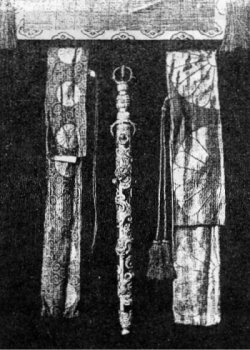 The hoh-ken (treasure sword) bestowed on Asahigata by Emperor Kohmei
Strictly speaking, the "Great Maitreya Kami" was NOT Foundress Nao but Kunitokotachi no Mikoto (alias "Ushitora no Konjin") who possessed her. The Omoto literature identifies Kunitokotachi as creator of the Earth and its spirit world. The webmaster suspects that Kunitokotachi is the same as Jehovah in the Bible. For details, see the following:
As shown in the excerpts below, Onisaburo says that the Great Maitreya Kami consists of three different Maitreyas: Heavenly Maitreya, Earthly Maitreya, and Human Maitreya.
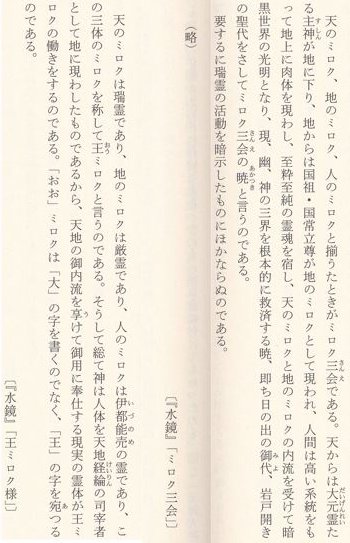 Excerpts from Onisaburo's Mizu Kagami (Water Mirror), a collection of "thus I hear (from Onisaburo)" accounts by his believers
To sum up the above:
| Type of Maitreya |
Type of Kami |
Type of Spirit |
| Heavenly Maitreya |
Kamususanowo no Oh Kami
- A manifestation of the Tenso (Progenitor of Heaven)
- The Creator of the whole universe and its great spirit world, and
- The saviour kami and the true protagonist in the Reikai Monogatari (Tales of the Spirit World)
|
Mizu Spirit |
| Earthly Maitreya |
Kunitokotachi no Mikoto
- The Kokuso (Progenitor of the Earth), and
- The creator of the Earth and its spirit world
|
Izu Spirit |
| Human Maitreya |
Onisaburo Deguchi |
Izunome Spirit |
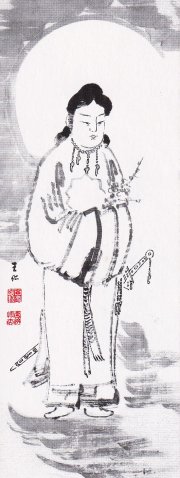 |
|
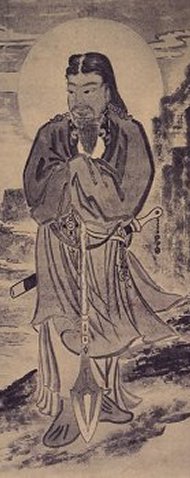 |
| Kamususanowo no Oh Kami (right) and Kunitokotachi no Mikoto (left) |
Incidentally, Reiwa 10 (2028) marks the centenary (100th anniversary) of Onisaburo's declaration of his earthly descent as Miroku no Oh Kami manifested, which took place on March (3th month) 3, Showa 3 (1928), with three 3's indicating auspiciousness. On this day Onisaburo turned 56 years and 7 months, or 5-6-7 (mi-ro-ku). "Miroku" is the Japanese transliteration of "Maitreya."
Unfortunately, Asahigata did not have the chance to meet Onisaburo as Miroku no Oh Kami (= the trinity of Heavenly, Earthly and Human Maitreyas) during his lifetime, but he met with Earthly Maitreya (= Kunitokotachi no Mikoto) as a forerunner of Onisaburo through the Foundress. That was why Asahigata felt unusually elated when Nao gave him Emperor Kohmei's divine name.
Founding of Tamahoko Shrine
Emperor Kohmei died on December 25, Keio 2 (1866). His body was laid to rest at Sen-nyuji Temple in the Higashiyama district of Kyoto.
On March 23, Meiji 29 (1897), Asahigata provided the temple with 500 yen in permanent memory of his beloved Emperor, which must have been quite a large sum of money at that time. And in Meiji 30 (1898), he donated 100 yen for holding memorial services for the late Empress Kohmei.
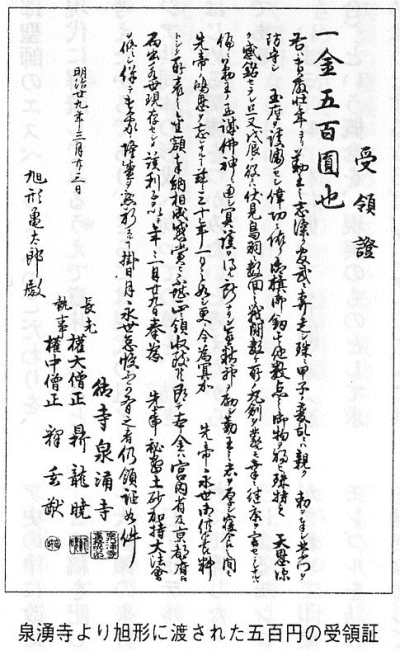
Sen-nyuji Temple's receipt of 500 yen from Asahigata
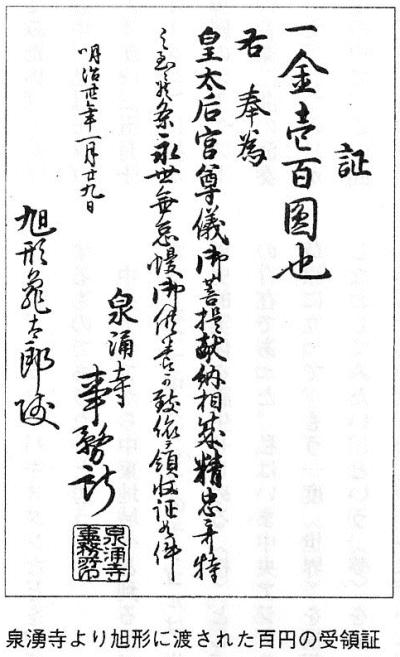
Sen-nyuji Temple's receipt of 100 yen from Asahigata
Asahigata's love and respect for Emperor Kohmei remained unchanged 34 years after his demise.
Asahigata and Sato returned triumphantly with the divine name of Emperor Kohmei, but still, no permission was granted to them to build a shrine in the emperor's honor.
Thanks to Aichi Governor's efforts, it was decided that an old Hachiman shrine in a rural village some 20 kilometers from Nagoya would be moved to Taketoyo, and that the spirit of Emperor Kohmei would be co-enshrined with the Hachiman deity.
At the same time, Asahigata learned Kokugaku (National Learning) and obtained a certificate as a Shinto priest. This showed how much he was committed to worshipping the spirit of the late Emperor Kohmei.
Current State of Tamahoko Shrine
On February 20, 1998, Mr. Yasuaki Deguchi and others visited Tamahoko Shrine.
The shrine was located atop a hill. Within its compounds were no visitor-soliciting brochures or paper fortunes. It was exuding an aura of aloofness.
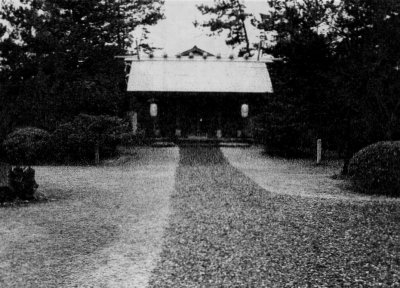
Tamahoko Shrine in 1998
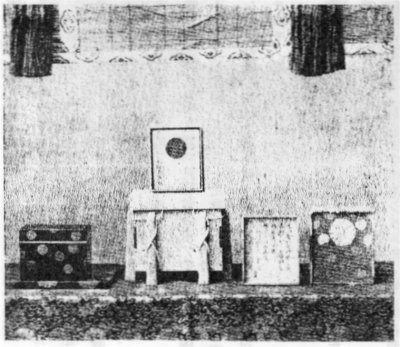
Emperor Kohmei's gokoshoh (five-pronged pestles) at Tamahoko Shrine
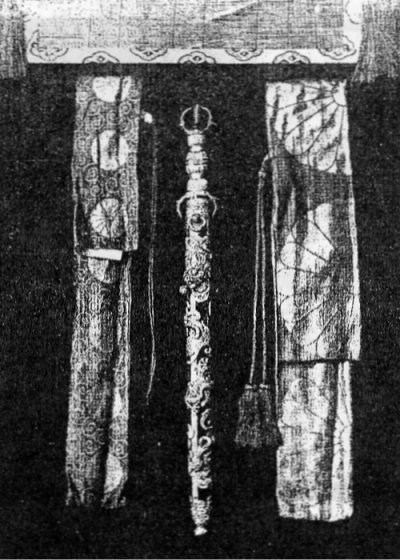
Emperor Kohmei's hoh-ken (treasure sword)
The former priest of the shrine was Mr. Mitsuhiko Asahigata. He was 92 years old and bedridden due to his encephalomalacia. His wife, Yukino, was 74 years old, and she was the one who welcomed the visitors from Kyoto.
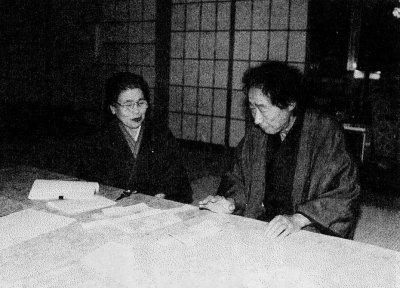
Ms. Yukino Asahigata (left) and Mr. Yasuaki Deguchi (right)
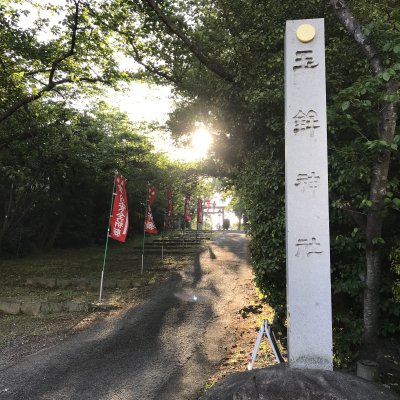 Tamahoko Shrine in 2019 (May 4, Reiwa 1)
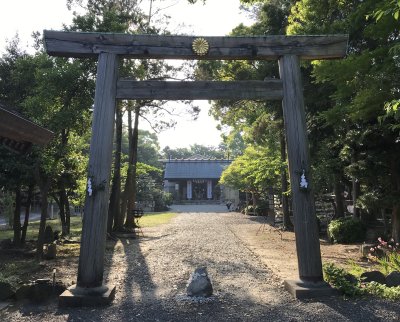 Shrine Gate (May 4, Reiwa 1 [2019])
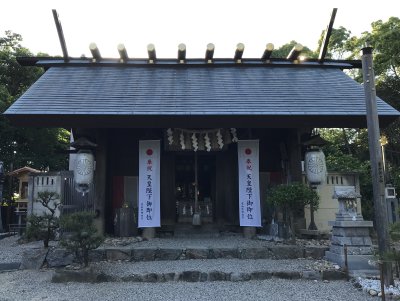 Main Shrine (May 4, Reiwa 1 [2019])
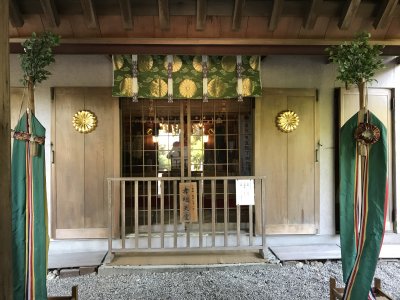 Main Shrine (May 4, Reiwa 1 [2019])
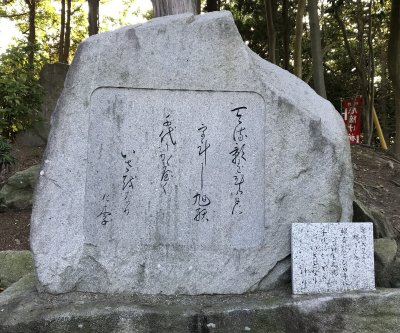 Emperor Kohmei's 31-syllable waka poem hailing Asahigata's brave rescue of the emperor (May 4, Reiwa 1 [2019])
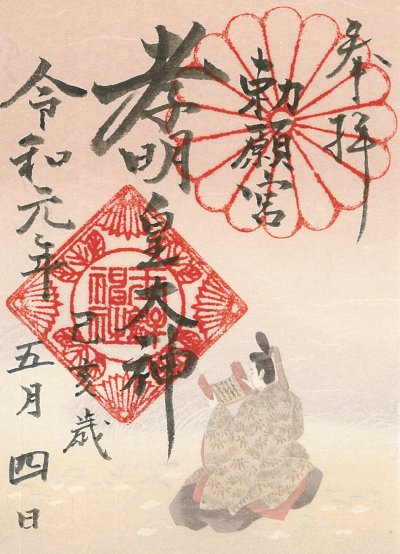 A seal distributed at Tamahoko Shrine
Mitsuhiko was the third-generation priest. The second-generation priest, Kamenosuke Asahigata, had no children of his own, and adopted Mitsuhiko and Yukino. Their oldest son, Yukihiko, presently serves as the fourth-generation priest.
Interestingly, Mitsuhiko Asahigata, or Mitsuhiko Wakabayashi by maiden name, used to be an Omoto believer.
For details, please check the following sites:
Asahigata's Deathbed Will
Monjiro Sato's Tamahoko no Hikari (original Japanese text) indicates that his master Kametaro Asahigata left his de facto will on January 1, Meiji 34 (1901).
Asahigata's will can be summarized as follows:
(He was such a psychic that he was able to foresee what would happen to himself, Omoto, and Tamahoko Shrine.)
- Asahigata felt that he would not recover from his illness, and that he would have to leave this world this year. That was why he wanted to leave his will on auspicious New Year's Day to his family, his disciples, the Governor of Aichi Prefecture and others, who had come to inquire about his health.
- Asahigata entrusted Sato with (1) Emperor Kohmei's handwritten message on a square fancy board, (2) 150 yen in cash (probably worth about a million yen in today's money), and (3) eight 3.6 cm reichiku (spiritual flutes). He forbade his disciple to show or talk about those items until the Imperial Year 2600 (or 1940 AD), and asked him to hand over the three items to the man in question when the year actually came. This man would turn 70 in the Imperial Year 2600.
- Asahigata predicted that terrible events would happen to Tamahoko Shrine, adding that he would bequeath this shrine to the Town of Taketoyo, but not to his descendants.
➡ The terrible events happened after Asahigata's death when the construction of Tamahoko Shrine was suspended at its initial stages, when the shrine's treasures were stolen, and when there was no replacement found for the shrine priest for a while.
- Asahigata also predicted that terrible events would happen to Omoto in Ayabe, Kyoto.
➡ His prediction proved accurate when the Japanese government oppressed Omoto twice in Taisho 10 (1921) and Showa 10 (1935).
- Asahigata requested that his corpse be examined in an autopsy for academic research data.
With these words, Asahigata passed away on March 11, Meiji 34 (1901) at age 61.
Since then Sato had waited and waited to hand over the three items above to the man in question when the Imperial Year 2600 (1940 AD) actually came. This man would turn 70 in that year. There were probably tons of men who would turn 70 in that year, but Emperor Kohmei's handwritten message on a square fancy board indicated that the man in question was supposed to have the "Seal of the Deity of Su" (see below).
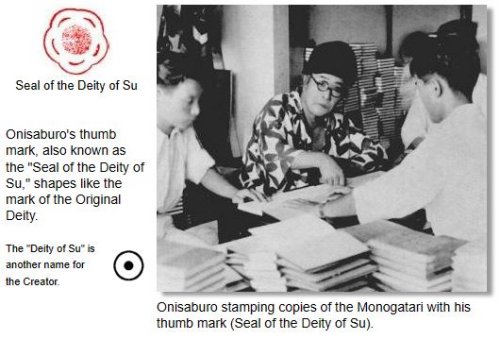 Onisaburo's thumb mark, also known as the "Seal of the Deity of Su," shapes like the mark of the Original Deity. (Source: The Aizen-en)
 A tiny hole in the center of Onisaburo's thumb mark (red portion) makes it look like  , a symbol of the Deity of Su (Creator)
In Showa 10 (1935), however, Sato was embroiled in the government persecution of Omoto known as the Second Omoto Incident. In the following year (Showa 11, 1936), the police raided his home and forced him to burn Emperor Kohmei's handwritten message on a square fancy board.
Sato enshrined Emperor Kohmei's handwritten message on a square fancy board in his family altar, along with Omoto's go-shintai (Kami-body; an object in which the kami inheres). But those police officers who searched Sato's house ordered him to burn Emperor Kohmei's memorabilia as they were defiled by the Omoto's kami.
Sato took Emperor Kohmei's fancy board message to the Shima no Uchi Police Station in Osaka twice to ask the officers to examine the message closely, adding that it had nothing to do with the Omoto religion. But they never even tried to examine it either time, and they only persisted in arguing that the emperor's message board was defiled and thus needed to be burned. In response, Sato walked them through the complete accuracy of Emperor Kohmei's prophecies in the message and their corresponding events in the world so far. The police officers nodded their understanding of those prophecies with wonder and admiration before they suddenly changed their minds due to the next prophecy about Showa 12 (1937):
Showa 12 (1937) will witness a planetary alignment and mark the 12,000th anniversary of the Deluge. This year will signal the start of the great demolition, the great crisis of the world.
It would be better off not to take this prophecy literally as it is apparently based on the following numerical table:
 A numerical table
Given its significance, this prophecy will be explained in great detail later.
Angered by the prophecy above, the officers at the Shima no Uchi Police Station in Osaka said, "Talk about next year and the devil will laugh. Omoto is outrageous because it misleads the public with false prophecies when it actually does not know anything about future events. Just destroy the emperor's message board right away, or we will execute you together with Onisaburo."
"With all due respect," Sato replied indignantly. "What does this message board have to do with Omoto?"
The officers distorted the truth and said, "Onisaburo has used the message board to found Omoto and make prophecies."
Sato could not stand the officers' narrative that sounded as if Onisaburo had prophesied up to that moment based on Emperor Kohmei's message, and countered, "I have been ordered to keep all the truth to myself until the Imperior Year 2600 (1940) comes around. Not even once have I talked about it or shown it to anyone. I have simply been awaiting the Imperior Year 2600 while strictly observing the dying orders of Emperor Kohmei and Master Asahigata."
Much to his chagrin, the officers never understood Sato's logical explanation. He thought that he would lose everything if he opposed them and were put in prison instead. He was the only one left in the material world who could fulfill the dying orders of the Emperor Kohmei and Master Asahigata, as shown below:
- Asahigata entrusted Sato with (1) Emperor Kohmei's handwritten message on a square fancy board, (2) 150 yen in cash (probably worth about a million yen in today's money), and (3) eight 3.6 cm reichiku (spiritual flutes). He forbade his disciple to show or talk about those items until the Imperial Year 2600 (or 1940 AD), and asked him to hand over the three items to the man in question when the year actually came. This man would turn 70 in the Imperial Year 2600.
To this end, Sato begrudgingly destroyed the emepror's message board by fire under the coersion of the police officers.
Emperor Kohmei's Prophecy about Showa 12 (1937)
As stated earlier, it would be better off not to take the next prophecy literally as it is apparently based on the numerical table.
Showa 12 (1937) will witness a planetary alignment and mark the 12,000th anniversary of the Deluge. This year will signal the start of the great demolition, the great crisis of the world.
To add to the above, Sato heard the following from Asahigata:
- A planetary alignment: three planets revolving near the Earth counterclockwise, and three planets revolving near the Earth clockwise will be in alignment with one another including the Earth, and
- Showa 12 (1937): As Asahigata told Sato, developments in the world following the Marco Polo Bridge Incident of July 7, Showa 12 attest to the accuracy of Emperor Kohmei's message.
Wikipedia - The Marco Polo Bridge Incident
The prophecy says that Showa 12 (1937) will mark the 12,000th anniversary of the Deluge.
An analytical investigation of the Bible suggests that the Deluge is presumed to have occurred over 2000 BC. The presumed ruins of Noah's Ark on Mount Ararat in Turkey are said to date from 4500 - 5000 BC.
12,000 years is much longer than the above.
The number "12,000 years" reminds some people of Churchward's theory in which he claims that the lost continent of Mu sank into the sea about 12,000 years ago.
In Taisho 11 (1922), four years earlier than Churchward's publication, Onisaburo already mentioned the existence of a lost continent called the Yomotsu-jima (Island of Hades) on the Pacific Ocean.
When Onisaburo read a newspaper article about Churchward's research on Mu, he equated Mu with the Island of Yomotsu in the Monogatari.
Volume 9 of the Monogatari says that the Island of Yomotsu, i.e. the lost continent of Mu, was 2,700 nautical miles (Approx. 5,000 kilometers; 1 nautical mile = 1,852 meters) long and 3,100 nautical miles (Approx. 5,741 kilometers) wide, as shown below:
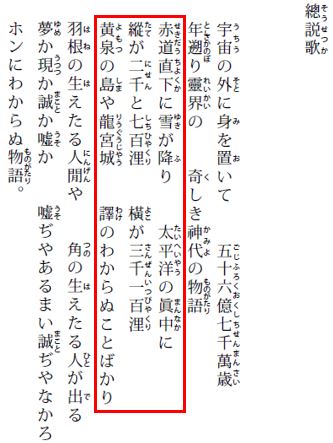 Dimensions of Island of Yomotsu (Vol. 9 of Reikai Monogatari)
Volume 12 describes how this continent, inhabited by growing numbers of evil deities, becomes a major battle field between good and evil deities, incurring its own demise in the depths of the ocean.
The following is an illustration of the lost continent of Mu (= the Island of Hades) carried in the Omoto literature before Japan's involvement in the Pacific War. Onisaburo once said that the Pacific War was a re-enactment of the battle at the Even Pass of Hades in the Kojiki (See [SECT. IX. - THE LAND OF HADES.])
 Island of Yomotsu (= Lost Continent of Mu)
Volume 12, Chapter 27 of the Reikai Monogatari says that the Island of Yomotsu has been subsiding 36-54 meters daily due to major earthquakes these days.
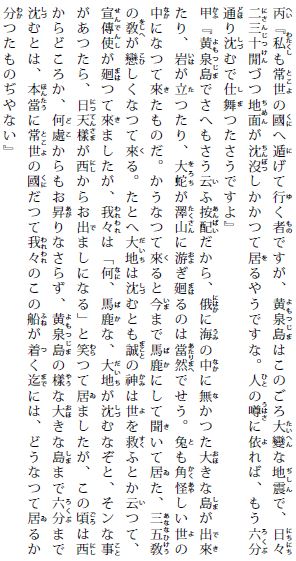 Excerpts from Vol. 12, Chap. 27 of Monogatari describing a significant daily ground subsidence of Island of Yomotsu
Similarly, Volume 13, Chapter 2 of the Reikai Monogatari says that the sinking of the Yomotsu Island has raised the sea level in the Persian Gulf, submerging virtually all low-lying coastal areas.
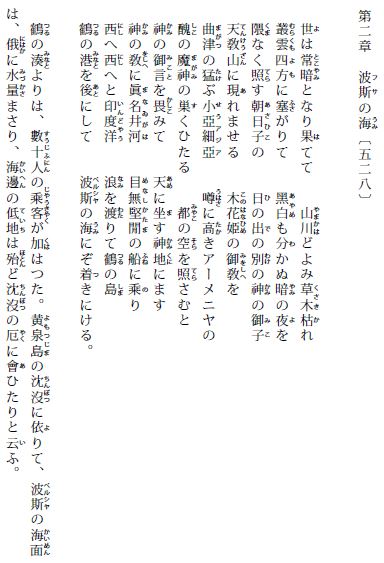 Excerpts from Vol. 13, Chap. 2 of Monogatari describing rising sea level in Persian Gulf due to sinking of Island of Yomotsu
In a sense, the above Monogatari excerpts remind people of the Deluge. The biblical great flood as mentioned in Emperor Kohmei's prophecy may have referred to the sinking of the Continent of Mu. Emperor Kohmei probably foretold that Showa 12 (1937) would mark the 12,000th anniversary of the sinking of the Continent of Mu, when an apocalyptic crisis of the world unfolded.
As for the planetary alignment, Sato heard Asahigata say that three planets revolving near the Earth counterclockwise and three planets revolving near the Earth clockwise would be in alignment with one another including the Earth.
Astronomically, however, a planetary alignment of this many planets is believed to be super rare if not impossible.
Moreover, major planets revolving around the Sun, namely, Mercury, Venus, Earth, Mars, Jupiter, Saturn, Uranus, Neptune, and Pluto (dwarf planet, though), revolve around the Sun in the same direction. Therefore, phrases like "counterclockwise" and "clockwise" sound inappropriate or even inaccurate.
Given these factors, Emperor Kohmei's prophecy about the planetary alignment is apparently based on the following numerical table:
This numerical table is a 9 x 9 magic square, as shown below:
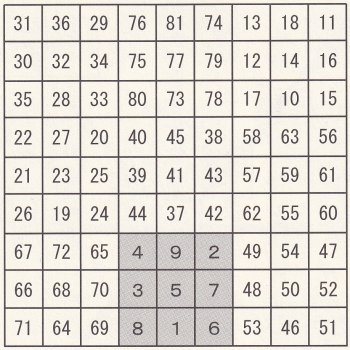 9 x 9 magic square (Gray area: Order 3, and magic constant is 15)
A 9 x 9 magic square means that with order 9, the magic constant is 369.
It is interesting to note that 369, or 3(mi)-6(ro)-9(ku) = miroku, is a Japanese transliteration of "Maitreya" just like 567, which can be read as 5(mi)-6(ro)-9(ku) = miroku.
The numerical table is different from standard magic squares in that the former starts with the square at the top right-hand corner (1), repeats going down from top to bottom squares, and ends with the square at the bottom left-hand corner (81), as shown below:
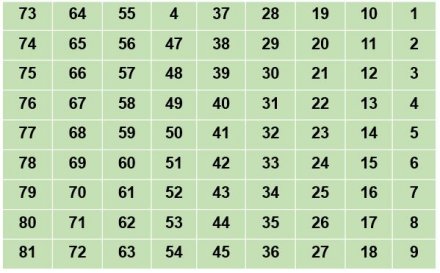 Square No. arrangement of the numerical table
Square No. 41 (located in the exact center) is the same for both the numerical table and standard magic squares.
There is a little comment in multiple squares of the grid, and some of those squares are listed below for their importantce:
| Square No. |
Image |
Description |
| 41 |
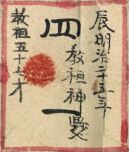 |
"Year of dragon, Meiji 25 (1892). Foundress possessed by the Divine. Foundress at age 57"
(Note)
Foundress Nao Deguchi was possessed by Kunitokotachi no Mikoto (dubbed Ushiora no Konjin) at the kazoedoshi age of 57.
The age 57 mentioned here is based on the kazoedoshi method of age counting where a baby is counted as one year old at birth (after only nine months in the womb) and thereafter becomes a year older at every New Year, rather than on its birthday. This results in people usually being one or two years older than by western calendar. |
| 49 |
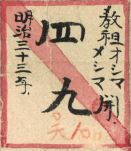 |
"Foundress opened Meshima and Oshima islands. Meiji 33 (1900)"
(Note)
One square apparently represents one year. Square No. 49 (Meiji 33) - Square No. 41 (Meiji 25) = 8 squares. Meiji 25 + 8 squares (or 8 years) = Meiji 33.
In Meiji 33 (1900), divine ceremonies were performed to open the Meshima and Oshima islands floating in the Wakasa Bay so that the confined Ushitora no Konjin and his kindred deities/spirits could be freed. In fact, a party of Nao, Onisaburo, Sumi and others got into a small boat to land the islands and perform the ceremonies.
|
| 1 |
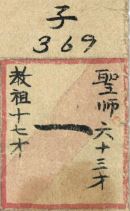 |
"Holy Master at age 63. Foundress at age 17"
(Note)
Onisaburo was and still is called 'Holy Master' by Omoto adherents.
This numerical table has a cycle of 81 years, as symbolized by 81 squares in the grid.
With Square No. 41 being equal to Meiji 25 (1892), Square No. 1 is Kaei 5 (1852) (i.e. 1892 - 40 = 1852).
Foundress Nao was born in Tempo 7 (1836), so she was at the kazoedoshi age of 17 in Kaei 5 (1852), as accurately indicated by Square No. 1.
Meanwhile, Onisaburo was born in Meiji 4 (1871). This table has a cycle of 81 years, so let us move to Square No. 81 and then go back to Square No. 1. The year 1852 (Square No. 1) plus 81 equals 1933 (Showa 8). As precisely mentioned, the year 1933 (Square No. 1) marks Onisaburo's kazoedoshi age of 63.
Outside of the square, though, there is a word that says the "year of the rat" above 369. This means that Square No. 1 represents the year of the rat according to the Chinese zodiac. |
| 3 |
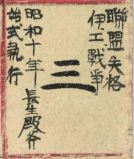 |
"Japan's withdrawal from League of Nations took effect. Italy at war with Ethiopia. Showa 10 (1935). A ceremony was held to start construction of Chohsei-den Hall"
(Note)
In Showa 10 (1935), the following three things happened:
- The withdrawal application Japan had made with the League of Nations in Showa 8 (1933) officially came into force.
- Italy invaded Ethiopia to colonize it (The Second Italo-Ethiopian War), and
- Omoto performed a ceremony to start full-scale construction of the Chohsei-den Hall atop Mount Hongu in the religious group's holy land of Ayabe, Kyoto.
|
| 9 |
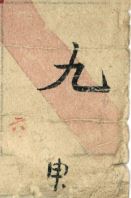 |
(Note) Outside of the square, though, there is a word that says the "year of the monkey." This means that Square No. 9 represents the year of the monkey according to the Chinese zodiac. |
| 5 |
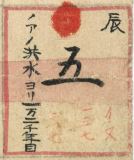 |
"Year of dragon. 12,000th anniversary of the Deluge" |
| 77 |
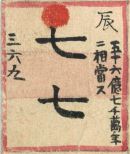 |
"Year of dragon. Corresponds to 5.67 billionth year. 369"
(Note)
Both "567" and "369" signify the "Great Maitereya Kami" in Omoto parlance as they can be read as "Miroku," a Japanese transliteration of "Maitreya". |
A closer look at the numerical table will find a red dot in each of the seven "year of the dragon" squares, as shown below:
| Square No. |
Image |
| 41 |
 |
| 5 |
 |
| 77 |
 |
| 29 |
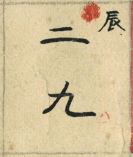 |
| 65 |
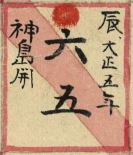 |
| 17 |
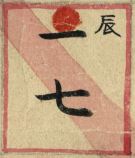 |
| 53 |
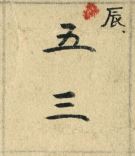 |
These red dots are actually Onisaburo's thumb mark called the "Seal of the Deity of Su" and what looks like his seal known as the "Mark of the Kami of Su."
The numerical table may have been prepared by someone other than Sato because he was illiterate. The reverse side of the table says, "Owned by Sato. Second half of Showa 8 (1933)" (see image below).
 Handwriting on back side of numerical table
This handwriting is clearly different from Onisaburo's. Then, whose handwriting is it?
Mr. Hisashi Deguchi, a co-author of An Unknown History of Japan, presumes that the handwriting could belong to Yasukuni Doi, a senior disciple of Onisaburo, and also the original owner of the old dusty box containing the Kirigami Shinji, four booklets, numerical tables and others.
Around the second half of Showa 8 (1933), Sato may have showed and explained the prototype of the numerical table to Doi, who in turn made a fair copy of it. Since then, words may have occasionally been added to many different squares in the grid. And when Sato successfully met with Onisaburo in Showa 17 (1942), the numerical table was probably approved by Onisaburo with his thumb mark called the "Seal of the Deity of Su" and what looked like his seal known as the "Mark of the Kami of Su."
More importantly, whoever prepared the numerical table, the "Seal of the Deity of Su" on it indicates Onisaburo's endorsement of the table.
Hakkoh Ichiu and Onisaburo's Ambition to Spiritually and Morally Unify the World
Hakkoh ichiu literally means "eight crown cords, one roof" or "all eight corners of the world under one roof."
Regrettably, hakkoh ichiu was a wartime political slogan that had incited the Japanese people to assist in the creation of the Greater East Asia Co-Prosperity Sphere with its hub being the Japanese Empire so that the Imperial Rising-Sun Nation could rule the whole world.
The hakkoh ichiu to be mentioned hereafter has nothing to do with the blood-tainted propaganda tool. Rather, it relates to the numerical table with eight light rays (= red diagonal lines) emanating from one roof (= Square No. 41), as shown below:
 The hakkoh ichiu numerical table
As an interesting pun, hakkoh ichiu nicely matches an 81-year cycle of the numerical table:
 Hakkoh ichiu puns on 81-year cycle of numerical table
As with hakkoh ichiu, Onisaburo was committed to unifying the world as one of his lifelong divine missions.
Onisaburo's ambition to unify the world was NOT of a material or political nature but of a spiritual and moral one. In other words, he strove to unify the world under the spirit of aizen (universal love and brotherhood), as shown in Volume 64 (Book 1) of the Reikai Monogatari:
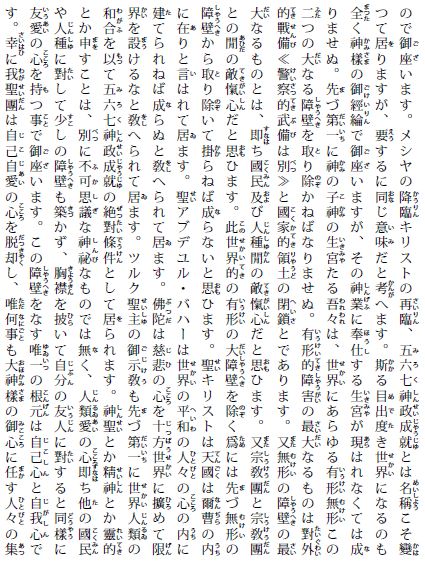 Excerpts from Volume 64 (Book 1) of Reikai Monogatari
Summary:
-
Onisaburo dictated Volume 64 (Book 1) to his scribes from July 10 by the solar calendar, or May 27 by the lunar calendar, Taisho 12 (1923) to July 13 by the solar calendar, or May 30 by the lunar calendar, Taisho 12 (1923), both inclusive.
-
Likewise, Onisaburo dictated Volume 64 (Book 2) to his scribes from August 19 by the solar calendar, or June 30 by the lunar calendar, Taisho 14 (1925) to August 21 by the solar calendar, or July 2 by the lunar calendar, Taisho 14 (1925), both inclusive.
-
Volume 64 (Books 1 & 2) is set in Jerusalem. It deals with such topics as the Second Coming of the Messiah, the relationship between Japanese and Jewish peoples, and the unification of the world. Interestingly, this volume witnesses the existence of a Jewish state in Palestine. In Taisho 12 (1923) or Taisho 14 (1925), when Onisaburo dictated Volume 64, Palestine was still under British rule. It can be said that Onisaburo had foretold the creation of Israel, which actually came true in May 14, 1948.
-
On the outskirts of Jerusalem is a towering grand structure called the American Colony, where about 100 people of diverse races and nationalities lead a communal life together as they look forward to the Second Coming of the Christ. These devout Christians include Swafford, a Jewish American and also the son of the founder of the American Colony, and Mary of Magdalene (NB: different from that biblical Mary of Magdalene), a local Jewish woman.
-
The American Colony bears the same name because it was founded by an American, but it is actually Swedes that currently account for the largest share of its membership. Members call one another brothers and sisters.
-
Swafford and Mary of Magdalene are among key figures leading the American Colony. Mary of Magdalene, past the age of 30, has remained celibate. Her trust in and devotion to the Lord are beautiful and praiseworthy.
-
Mary of Magdalene says that she views the Advent of the Messiah, the Second Coming of the Christ, and the Fulfillment of the Divine Reign of the Maitreya Kami as practically the same thing, albeit in differet names, and that the world is evolving into such an auspicious state thanks to the Kami's grand design.
-
As living shrines of the Kami, we human beings need to rid the world of two major types of barriers: tangible and intangible barriers.
-
The biggest tangible barriers are: (1) external preparations for war (excluding policing defenses), and (2) closure of national territories.
-
The biggest intangible barriers are: (1) animosity among different peoples or races, and (2) animosity among different religious groups.
-
To eliminate these global tangible barriers, we need to first get rid of intangible barriers.
-
What counts is the spirit of universal love and brotherhood, which means building no barriers with other peoples or races, and having a heart-to-heart talk with others as if they were your friends.
-
It is your selfishness and egocentricity that are at the very root of all these barriers.
As shown above, Onisaburo aimed to unify the world under the spirit of aizen (universal love and brotherhood), instead of through militarism or by any other similar means.
Some people might feel cautious about the phrase "unify the world" because of its possible association with some secret societies or conspiracy theories.
What those secret societies are doing is trying to unify the world - tangibly and physically - by manipulating the economy, politics, legal systems and the like.
Meanwhile, what Onisaburo strove to do while he was alive and still strives to do today as a spiritual being is to unify the world morally and spiritually based on the principle of reishu taiju (spirit over body), which means that spirit comes first, body comes next. According to Onisaburo, the world has been in disorder since ancient gods acted on the principle of taishu reiju (body over spirit), which prioritizes physical matters over spiritual ones. Spirit must triumph over body in line with the laws of the universe.
As stated above, hakkoh ichiu nicely matches an 81-year cycle of the numerical table. The 81 squares of the table can be related to the Reikai Monogatari, which also consists of 81 volumes. Let us cite Square No. 41, located in the exact center of the table, as an example:
| Square No. |
Image |
Description |
| 41 |
 |
"Year of dragon, Meiji 25 (1892). Foundress possessed by the Divine. Foundress at age 57"
(Note)
Foundress Nao Deguchi was possessed by Kunitokotachi no Mikoto (dubbed Ushiora no Konjin) at the kazoedoshi age of 57.
The age 57 mentioned here is based on the kazoedoshi method of age counting where a baby is counted as one year old at birth (after only nine months in the womb) and thereafter becomes a year older at every New Year, rather than on its birthday. This results in people usually being one or two years older than by western calendar. |
Volume 41 of the prophetic Reikai Monogatari suggests that Tomomi Iwakura, a court noble who would later become a major architect of the Meiji Restoration (1868-1889), plotted to remove Prince Taruhito of the House of Arisugawa from the Imperial succession by nullifying the Prince's long-time engagement to Princess Kazu, as shown in the red box below:
(Note)
- In the passage above, Tomomi Iwakura appears as 'Minister of the Right Karu-chin,' Prince Taruhito of the House of Arisugawa as 'King Seran,' and Princess Kazu as 'Yasudara-hime,' respectively.
 Tomomi Iwakura (1825-1883)
Historically, Emperor Kohmei (1831-1866) was perceived as an obstinate figure who clung to the idea of expelling foreign influence from Japan. For this reason, he begrudgingly nullified Prince Taruhito's long-time engagement to Princess Kazu, the Emperor's half-sister, to strengthen ties between the Imperial Court and the Tokugawa Shogunate by agreeing to marry Princess Kazu to the 14th Shogun Iemochi Tokugawa as his lawful wife.
(Volume 41 of the Reikai Monogatari suggests that this Imperial decision was based on Tomomi Iwakura's advice.)
The Tamahoko no Hikari indicates that Emperor Kohmei knew through the Kirgami Shinji that the United States would plot to invade Japan in the future. His adamant refusal to give in to foreign influence probably came from his conviction about this prophesied Japan-US war 80 years later.
 Prince Taruhito of House of Arisugawa
 Princess Kazu
 14th Shogun Iemochi Tokugawa
Having lost his fiancee, Prince Taruhito met 19-year-old Yone Ueda at a riverside inn in Meiji 1 (1868). Partly to console himself, and partly because he was attracted to her, the prince frequented this hotel to have an affair with Yone, with the culmination in the birth of Onisaburo Deguchi (original name: Kisaburo Ueda).
For details, see Prince Arisugawa's Tanzaku
 Yone Ueda, Onisaburo's mother, in later years
As with the above passage from Volume 41, Onisaburo included prophetic messages in the Monogatari in a subtle, somewhat convoluted fashion because state censorship was extremely strict in his era, with the freedom of speech or expression so limited that any inappropriate reference, especially to the Emperor and his sovereignty system, would trigger a publishing ban.
Volume 41 features Emperor Kohmei, Prince Taruhito of the House of Arisugawa, Tomomi Iwakura, and Princess Kazu, as well as their love-hate relationship drama. Prince Taruhito is forced to separate from Pricess Kazu, his long-time fiancee, during a period of political turbulence. This volume led to the birth of Onisaburo Deguchi as a saviour and hence deserves its place as the seed (kernel) of the 81-square numerical table.
Add three 3's to three 7's to make three 10's
 The hakkoh ichiu numerical table
Sato writes in his Tamahoko no Hikari that the world, when seen in the light of major events on July 7, Showa 12 (1937) and beyond, has been unfolding according to Emperor Kohmei's handwritten messages.
What happened on July 7, Showa 12 (1937)?
Answer: The Marco Polo Bridge Incident, a skirmish between China's National Revolutionary Army and the Imperial Japanese Army, which escalated into the Second Sino-Japanese War, and eventually World War II.
Wikipedia - The Marco Polo Bridge Incident
The numerical table mentioned so far is regarding Omoto. But there are other numerical tables discovered, including that for the Holy Master (Onisaburo Deguchi). Let us compare Square No. 5's between the numerical table for Omoto and that for the Holy Master, as shown below:
| About |
Square No. |
Image |
Description |
| Omoto |
5 |
 |
"Year of dragon. 12,000th anniversary of the Deluge" |
| Holy Master |
5 |
N/A |
"Showa 12 (1937). Holy Master at age 67. Start of demolition. Second Sino-Japanese War"
|
The square located at the opposite end of the straight line from Square No. 5 through Square No. 41 is numbered 77 (see below):
| About |
Square No. |
Image |
Description |
| Omoto |
77 |
 |
"Year of dragon. Corresponds to 5.67 billionth year. 369"
(Note)
Both "567" and "369" signify the "Great Maitereya Kami" in Omoto parlance as they can be read as "Miroku," a Japanese transliteration of "Maitreya".
|
Square No. 77 can be identified as March 3, Showa 3 (1928) because on this day, Onisaburo declared his earthly descent as Miroku no Oh Kami manifested, and because he composed a poem on New Year's Day in Showa 3 (1928) to the effect that this year marked the 5.67 billionth year since the beginning of this world.
March (3rd month) 3, Showa 3 (1928) is an auspicious day due to three 3's (NB: 3 is a holy number).
March 3, Showa 3 (1928) also celebrated Onisaburo's 56th year and 7th month birthday.
When Square No. 77 is Showa 3 (1928), Square No. 5 is Showa 12 (1937) based on the 81-year cycle of the numerical table:
| Square No. |
Year |
| 77 |
Showa 3 (1928):
Onisaburo's declaration of his earthly descent as Miroku no Oh Kami manifested |
| 78 |
Showa 4 (1929) |
| 79 |
Showa 5 (1930) |
| 80 |
Showa 6 (1931) |
| 81 |
Showa 7 (1932) |
| 1 |
Showa 8 (1933) |
| 2 |
Showa 9 (1934) |
| 3 |
Showa 10 (1935) |
| 4 |
Showa 11 (1936) |
| 5 |
Showa 12 (1937):
Outbreak of the Marco Polo Bridge Incident, which would later escalate into the Second Sino-Japanese War, and eventually World War II. |
This way Square Nos. 77 and 5 form a straight line through Square No. 41:
The Marco Polo Bridge Incident in Square No. 5 broke out on July (7th month) 7, 1937 (Gregorian calendar) or 2597 (Imperial caledar) - namely, three 7's, or 777.
Incidentally, "193" of 1937 can be read as "i ku sa," meaning "war" in Japanese. "259" of 2597 can be read as "ji go ku," meaning "hell" in Japanese.
Onisaburo's declaration of his earthly descent as Miroku no Oh Kami manifested in Square No. 77 took place on March (3rd month) 3, Showa 3 - namely, three 3's, or 333.
"333" and "777" remind the webmaster of what Onisaburo told to the presiding judge at the Kyoto District Court in Showa 13 (1938) about the significance of the Maitreya Festival of March 3, Showa 3 (1928):
Summary:
-
The Grand Festival of the Maitreya Kami was celebrated on March 3, Showa 3 (1928) to add "333" to "777" to make "10 10 10" (three 10's), because "777" is considered a great unlucky number and needs to be neutralized.
Note 1: The kanji character for 10 (see below) is a sacred number as it represents "kami," "cross," "perfection," "fullness," and other qualities.
Note 2: "777" is considered a great unlucky number based on a Buddhist sutra.
-
In other words, Onisaburo strove to avert or mitigate the global apocalypse by balancing out "777" (the Marco Polo Bridge Incident) with "333" (the Grand Festival of the Maitreya Kami) to create "10 10 10" (divine teachings) when he turned 56 years and 7 months on March 3, Showa 3 (1928).
Now, let us go back to Emperor Kohmei's prophecy about Showa 12 (1937):
Showa 12 (1937) will witness a planetary alignment and mark the 12,000th anniversary of the Deluge. This year will signal the start of the great demolition, the great crisis of the world.
To add to the above, Sato heard the following from Asahigata:
- A planetary alignment: three planets revolving near the Earth counterclockwise, and three planets revolving near the Earth clockwise will be in alignment with one another including the Earth, and
- Showa 12 (1937): As Asahigata told Sato, developments in the world following the Marco Polo Bridge Incident of July 7, Showa 12 attest to the accuracy of Emperor Kohmei's message.
"A planetary alignment" mentioned above might refer to the following portion of the numerical table, with three squares (= planets) between Square Nos. 77 and 41 (= the Earth) being aligned with three squares between Square Nos. 41 and 5.
Emperor Kohmei's prophecy said that when this planetary alignment was formed, i.e. when the Grand Festival of the Maitreya Kami and the Marco Polo Bridge Incident materialized, it would trigger the start of the great demolition, the great crisis of the world - probably World War II.
To avert or mitigate this global apocalypse, Onisaburo prepared 333 arks, as shown in Chapter 22, Volume 5 of the Reikai Monogatari.
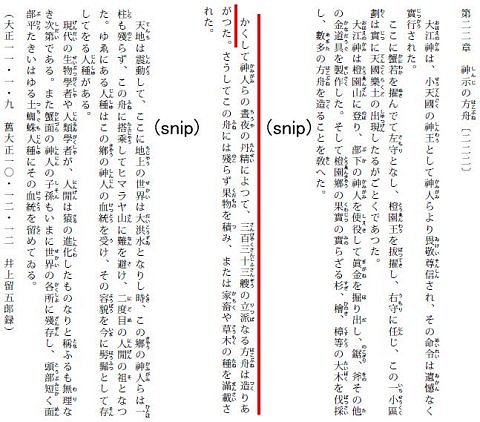 Volume 5, Chapter 22, "Arks Built on the Kami's Orders"
The red line in the image indicates that 333 arks of salvation have been built by the Kami's orders to protect against the global impact of the sunken Yomotsu Island (= Continent of Mu) some 12,000 years back.
Hence, "333" symbolizes divine salvation.
The Great Hakkoh Ichiu Project to be Completed in a Place with Eight Wells
In the Tamahoko no Hikari (original Japanese text), Asahigata quotes Emperor Kohmei (1831-1866) as saying:
- Emperor Jimmu (the legendary first emperor of Japan) made a great declaration of the hakkoh ichiu project in Kashihara when eight wells were bestowed on him by the Kami;
- The emperor named one of his princes Kamu Yaimimi no Mikoto (The August Deity Eight-Well Ears) after this honorable event;
- The source of life is water, hence wells (deep holes in the ground from which people obtain water); and
- The hakkoh ichiu project will reach completion only in a place with eight wells.
 The Great Hakkoh Ichiu Project to be completed in a place with eight wells (Excerpts from the Tamahoko no Hikari)
Sato went to Kashihara in Nara Prefecture to see if there were literally eight wells as mentioned by Emperor Kohmei. But he found only seven, not eight. This made him think that the place name 'Kashihara' was probably used figuratively and should not be taken as it was.
Sato used the Kirigami Shinji (Cut-Paper Revelation), and based on its revelation, he went to Ayabe in northern Kyoto but could not identify the number of wells in Omoto's Ayabe sanctuary amid the aftermath of the Second Omoto Incident of Showa 10 (1935). At that time, he met the owner of a mochi (rice cake) shop as he stopped by there. The owner was preparing to go to Kameoka, also in northern Kyoto, to bring sweet mochi cakes to Hidemaru Deguchi, the husband of Omoto's Third Spiritual Leader Naohi Deguchi. Sato decided to accompany the owner to Kameoka. On a train he asked the owner how many wells there were in the Ayabe holy sanctuary, while praying in his mind to Onisaburo Deguchi for an answer through the owner's mouth, and the owner made an instant reply, "Eight." This left Sato speechless with tremendous excitement.
In Showa 18 (1943), Sato asked Jinsai Yuasa, a senior Omoto member, to count the exact number of wells within the Ayabe sanctuary, and Yuasa reconfirmed it as eight. This provided further proof that the hakkoh ichiu project would commence, proceed and reach completion at none other than the Ayabe holy ground.
Emperor Jinmu, Prince Kamu Yaimimi no Mikoto, and Emperor Kohmei were reincarnated!
In the Tamahoko no Hikari (original Japanese text), Asahigata quotes Emperor Kohmei (1831-1866) as saying:
- The Japanese emperor in the Imperial Year of 2561 (Meiji 34 = 1901) will be Empeor Jinmu (the legendary first emperor of Japan) reincarnated;
- Kamu Yaimimi no Mikoto (The August Deity Eight-Well Ears), a prince of Emperor Jinmu, will be reborn as an imperial prince;
- Emperor Kohmei told Asahigata that he would be reincarnated as a 6-year-old prince; and
Note: The age six mentioned here is based on the kazoedoshi method of age counting where a baby is counted as one year old at birth (after only nine months in the womb) and thereafter becomes a year older at every New Year, rather than on its birthday. This results in people usually being one or two years older than by western calendar.
- When the 6-year-old prince turns nine in the Imperial Year of 2603 (Showa 18 = 1943), a fateful event will occur.
Note: The age nine mentioned here is based on the kazoedoshi method of age counting where a baby is counted as one year old at birth (after only nine months in the womb) and thereafter becomes a year older at every New Year, rather than on its birthday. This results in people usually being one or two years older than by western calendar.
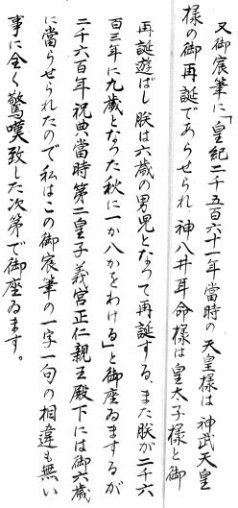 Emperor Jinmu, Prince Kamu Yaimimi no Mikoto, and Emperor Kohmei were reincarnated (Excerpts from the Tamahoko no Hikari)
Sato marveled at the accuracy of Emperor Kohmei's words when he learned about a 6-year-old prince named Prince Masahito of the House of Hitachi, the second son of Emperor Showa (Hirohito), in the Imperial Year of 2600 (Showa 15 = 1940).
Note: The age six mentioned here is based on the kazoedoshi method of age counting where a baby is counted as one year old at birth (after only nine months in the womb) and thereafter becomes a year older at every New Year, rather than on its birthday. This results in people usually being one or two years older than by western calendar.
For further details, check the following websites:
The Japanese emperor in the Imperial Year of 2561 (Meiji 34 = 1901) was Emperor Meiji. Therefore, Emperor Meiji would be Empeor Jinmu reincarnated, as suggested by Emperor Kohmei's revelation.
The imperial prince whose past life was Kamu Yaimimi no Mikoto remains to be seen. He could be Emperor Taisho (a prince of Emperor Meiji), Emperor Emeritus (the older brother of Prince Hitachi), or.... Further research is required.
Emperor Kohmei's revelation also foresaw that a fateful event would occur in the Imperial Year of 2603 (Showa 18 = 1943). This fateful event can be related to the Kami's 3,000-year program that has been underway since Showa 18 (1943).
The following are some 31-syllable poems from Onisaburo's Gessho-zan (Moonlit Mountain) anthology:

Now let us focus on Poem Nos. 1546, 1549, 1550, 1551, and 1552.
- No.1546: Now that the 50-year chi-no-jumbi shingyo (divine work on earth for the preparation of the Age of Maitreya) has been completed, Showa 18 (1943) marks the first year of the Kami's 3,000-year program.
Note: "3,000 years" is a figurative expression for "a long time" or "countless years" and therefore should not be taken literally.
Also note: "18" as in Showa 18 implies "Maitreya" as 18 = 3 [mi] x 6 [roku] = miroku = Japanese transliteration of "Maitreya."
- No.1549: January 1, Showa 18 (1943) marks the completion of the 50-year divine preparation on earth.
Note: The founding of Omoto in Meiji 25 (1892) and its activities until January 1, Showa 18 (1943) are considered the "preparation phase" (lead time) for the 3,000-year program.
- No.1550: The 3,000-year incarceration of Supreme Deity Kunitokotachi of the Earth's divine world ended in Meiji 24 (1891).
Note: The end of Kunitokotachi's incarceration is followed by Ushitora no Konjin (= Kunitokotachi)'s possession of Nao Deguchi in Meiji 25 (1892), with the famous declaration through her mouth: "The Greater World shall burst into bloom as plum blossoms at winter's end. Ushitora no Konjin has come to reign at last."
Please refer to Volume 4 of the Reikai Monogatari for details of Kunitokotachi's incarceration.
- No.1551: Showa 18 (1943) witnesses the curtains of the Kami's 3,000-year program open to remodel the world.
- No.1552: Everything is all set to replace the 50-year preparation with the Kami's 3,000-year program.
Reiwa 6 (2024) marks the 81st anniversary of the ongoing 3,000-year divine program.
It remains to be seen whether the 81st anniversary is associated with the 81-year cycle of the hakkoh ichiu numerical table.
 Hakkoh ichiu puns on 81-year cycle of numerical table
Sato's Long-Awaited Encounter with Onisaburo
Monjiro Sato had longed to meet Onisaburo Deguchi for more than 40 years since he took over the mission of his master Kametaro Asahigata in Meiji 34 (1901).
Sato's long-awaited encounter with the man having the "Deity of Su" thumb mark came true on September 7, Showa 17 (1942), as evidenced by the following excerpts from Onisaburo's Gessho-zan (Moonlit Mountain) anthology:
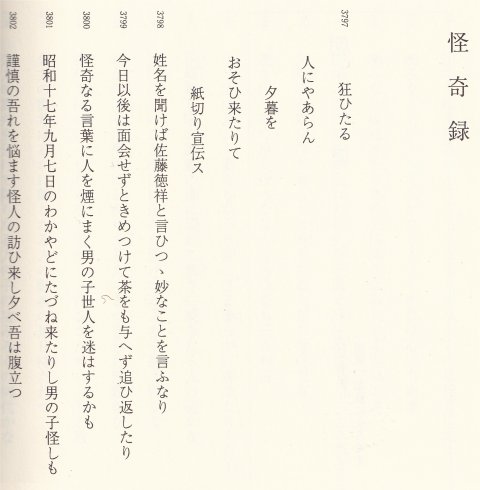 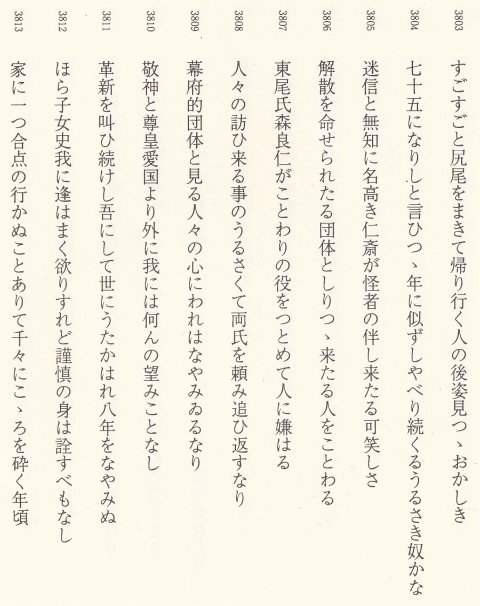 Sato's encounter with Onisaburo as described in the Gessho-zan anthology (Poem Nos. 3797 - 3805)
- Poem No. 3797: A crazy man stormed my (Onisaburo's) place at dusk and advertised the Kirigami Shinji.
- Poem No. 3798: This man said that his name was Monjiro Sato when asked, and also talked about strange things.
- Poem No. 3799: I decided to no longer see him again for the rest of today and beyond, and drove him away without serving him green tea.
- Poem No. 3800: The man good at baffling people with his weird words might mislead the general public.
- Poem No. 3801: On September 7, Showa 17 (1942), the suspicious man knocked on my door.
- Poem No. 3802: I was offended by the weird man, who visited my place at dusk and annoyed me while I was ordered by the court to stay at home.
- Poem No. 3803: The sight of the man turning tail and running is hilarious.
- Poem No. 3804: He said he was 75 years old, but despite his age, he just talked on and on. What a noisy guy!
- Poem No. 3805: The funny thing is Jinsai Yuasa, a senior Omoto believer renowned for his superstition and ignorance, brought this suspicious man to me.
You might think that their encounter must have been moving and dramatic. Actually, it turned out that Onisaburo regarded Sato as crazy and showed him the door without serving him green tea - at least in writing (for a reason to be explained later).
But other poems seem to belie the way Onisaburo dealt with Sato. For example, he lent an ear to what Sato said, as suggested by "...he just talked on and on. What a noisy guy!" Similarly, Onisaburo would never describe Jinsai Yuasa, one of his close confidants, as "renowned for his superstition and ignorance" unless he did it on purpose.
Furthermore, Onisaburo bothered putting down the date of his meeting with Sato (September 7, Showa 17), probably to leave evidence.
The situation surrounding Onisaburo in those days can explain why he composed the above seemingly contradictory poems. He came back home on parole, and his court battle was still ongoing.
Earlier, on July 31, Showa 17 (1942), a judgment was rendered in the second instance over the Second Omoto Incident. Onisaburo and his senior believers were found not guilty of violating the Maintenance of the Public Order Act, but were convicted of lese-majeste and sentenced to five years in prison. Therefore, Onisaburo was kept under government surveillance and had to restrict meetings with his believers as he placed on probation.
Against this backdrop, if the authorities had heard or found out about "Emperor Kohmei's prophecies," it could have triggered another government persecution of Omoto including Onisaburo, his believers, and Monjiro Sato himself.
That is probably why Onisaburo, unable to tell the truth, intentionally branded Sato as a crazy man and showed him the door - in writing - when he actually met with Sato. To avert possible police questioning, Onisaburo even gave his poem nos. 3797 through 3813 the collective title 'A Bizarre Story.'
The Compilation of the Tamahoko no Hikari
Monjiro Sato finally fulfilled his long-awaited dream of meeting with Onisaburo on September 7, Showa 17 (1942).
But Sato could not hand over Emperor Kohmei's handwritten message board to the Great Maitreya Deity manifested because it had to be destroyed by order of the police (see above for details).
For this reason, Sato worked with Jinsai Yuasa to comile the Tamahoko no Hikari at the residence of Toyotaro Nishida, also an Omoto member. Sato dictated his encounter with his master Kametaro Asahigata all the way up to his meeting with Onisaburo. The dictation took a total of several months. It was proofread by Jinsai Yuasa, sorted out by Teruo Koba, an Omoto member, and fairly written by Toyotaro Nishida.
Kazuko Nakai, a daughter of Toyotaro Nishida, told Mr. Yasuaki Deguchi that Nishida was born on December 3, Meiji 23 (1890), that he had worked for some Omoto churches in Osaka before and after World War II, and that he passed away on December 31, Showa 25 (1950).
Nakai also knew Sato very well. She said that Sato used to head up an Omoto church somewhere in Japan.
The Tamahoko no Hikari was completed on August 25, Showa 18 (1943). About two and a half years after that, he passed away on March 2, Showa 21 (1946). He must have breathed a sigh of relief with the compiled booklet.
Afterwards, the Tamahoko no Hikari and another booklet titled The Teruhi no Kage were dedicated to Onisaburo, who would later entrust the booklets to Yasukuni Doi, one of his right-hand men. Doi passed away on January 9, Showa 39 (1964), when his wife handed over the box containing the booklets and others to Mr. Yasuaki Deguchi.
Mr. Deguchi had long consigned the box to oblivion, but it resurfaced in his memory for the first time in 34 years - on January 19, Heisei 10 (1998), the 50th anniversary of Onisaburo's ascesion to heaven - as if Onisaburo gave instructions to his grandson (see top for details).
Emperor Meiji: The First Unifier of Japan
Some readers might have a negative impression of Emperor Meiji after reading about the alleged assassination of Prince Mutsuhito and the ensuing usurpation of the Chrysanthemum Throne by Toranosuke Ohmuro (see above). But Onisaburo never takes a negative view of Emperor Meiji.
For example, Onisaburo says in the following essay collection that Emperor Meiji is the first unifier of Japan.
 Excerpts from the Tsuki Kagami (Lunar Mirror)
Summary:
- The Kami has been aiming to unify the world.
- Almost never had Japan been unified since olden times. The island nation was an arena of countless feudal lords. First came the reign of Nobunaga Oda, followed by Hideyoshi Toyotomi, and then Ieyasu Tokugawa, who commenced the Tokugawa Shogunate.
- It was Emperor Meiji who achieved a complete unification of Japan for the first time.
- The truth is that with Japan being a model of the world (see Dragon-Shaped Japanese Islands), the seed of this unification will be sown in the world so that it can grow on a global scale.
- Not even once has the entire world been unified, but it is gradually being unified according to the will of the Kami.
It can be inferred from the above that a seed of global unification was created in a nursery bed called Japan under Emperor Meiji's reign, and that the Kami will probably use this Japanese kata (model) to let the seed germinate throughout the world.
Onisaburo also says as follows:
 Excerpts from the Shingetsu no Kage (Light of the New Moon)
Summary:
- Emperor Jinmu (original name: His Augustness Kamu-yamato-ihare-biko) refers to a succession of Japanese emperors ranging from His Augustness Kamu-yamato-ihare-biko (= Emperor Jinmu) to the current emperor (= Emperor Showa).
- The first divine generation is Amaterasu Oh Kami (The Heaven-Shining-Great-August-Deity). The second divine generation is Masa-ka-a-katsu-kachi-hayabi-ame-no-oshi-ho-mimi-no-mikoto (His Augustness Truly-Conquer-I-Conqueror-Conquering-Swift-Heavenly-Great-Great-Ears). The third divine generation is Ame-nigishi-kuni-nigishi-ama-tsu-hi-daka-hiko-ho-no-ni-nigi-no-mi-koto (His Augustness Heaven-Plenty-Earth-Plenty-Heaven's-Sun-Height-Prince-Rice-ear-Ruddy-Plenty). The fourth divine generation is Ama-tsu-hi-daka-hiko-ho-ho-de-mi-no-mikoto (His Augustness Heaven's-Sun-Height-Prince-Great-Rice-ears-Lord-Ears). The fifth divine generation is Ama-tsu-hi-daka-hiko-nagisa-take-u-gaya-fuki-ahesu no mikoto (His Augustness Heaven's-Sun-Height-Prince-Wave-limit-Brave-Cormorant-Thatch-Meeting-Incompletely). And the sixth divine generation is Emperor Jinmu.
- The name for each divine generation above is like a title or rank. In fact, there were tens of successive emperors in the Amaterasu Oh Kami generation alone.
Onisaburo says that a succession of Japanese emperors ranging from Emperor Jinmu to Emperor Showa (1901-1989) is grouped together as the Emperor Jinmu Dynasty. In this respect, even if Emperor Kohmei and his son Prince Mutsuhito had been assassinated and Toranosuke Ohmuro had stolen the Chrysanthemum Throne to become Emperor Meiji, all of them would have been members of the Emperor Jinmu Dynasty.
In other words, it can be said that the role and mission of Japanese emperors remain the same even if the imperial lineage undergoes changes. This is in line with Onisaburo's notion of good and evil:
- There is no absolute good or absolute evil in the world, and
- There is evil in good, and there is good in evil.
Furthermore, the following excerpts indicate that if people really want Onisaburo to give them an example of something close to absolute good or absolute evil, he will point out love as the former and hatred as the latter, respectively.
 Excerpts from the Mizu Kagami (Water Mirror)
Interestingly, Onisaburo also says that the Kami often pretends to be evil, and that He does great good by pretending to do evil, as shown below:
 Excerpts from the Shingetsu no Kage (Light of the New Moon)
The Reikai Monogatari mentions that evil has a role to play. For a film, play or story to be successful, not only main characters but also villains need to perform well. The Kami often uses bad guys, wrongdoers, evil entities and others to achieve His ambition of creating a Maitreyan utopia on earth.
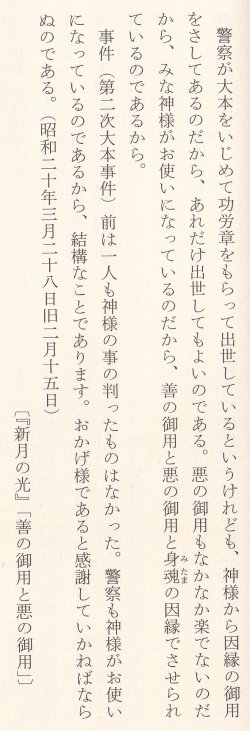 Excerpts from the Shingetsu no Kage (Light of the New Moon)
Summary:
- Some people criticize the police for being awarded the distinguished service prize for bullying Omoto. But they actually deserve the prize because they successfully played their unique role according to the Kami's scenario. They worked hard to fulfill their role, so they deserve the recognition.
- Villain roles are often hard to play, and the Kami uses all villains for His purposes.
- Generally, the Kami assesses individual humans and their souls, and lets some of them play good guys and others play bad guys.
- No one knew about the Kami, His plans and activities prior to the police raid of the Omoto sanctuaries (= the Second Omoto Incident of 1935). The Kami used the police for His purpose. We should be grateful to them.
The above suggests that the Kami uses whoever does evil as a villain for His theatrical play to make this world a better place.
For example, Onisaburo says in the following essay collection that no one knew who was behind U.S. General Douglas MacArthur or Soviet leader Joseph Stalin, and that both of them were actually used by the Kami to achieve His aims.
 Excerpts from the Shingetsu no Kage (Light of the New Moon)
The Minutes of a Pre-trial Hearing on the Second Omoto Incident Went to the Freemasonry Headquarters
In Showa 17 (1942), Onisaburo told his believers that Omoto would survive the existential ordeal posed by the Second Omoto Incident of 1935 because the minutes of a pre-trial hearing on the incident fell into the hands of the Freemasonry headquarters, as shown below:
 Excerpts from the Shingetsu no Kage (Light of the New Moon)
Onisaburo probably used his clairvoyance to witness the event.
The Second Omoto Incident is a direct persection of Omoto by the power of the Japanese state. It can be inferred from what Onisaburo says above that Freemasons were behind the incident.
If Freemasons read the minutes of the pre-trial hearing, why would it make Onisaburo say that Omoto would survive the existential ordeal?
One hypothesis would be that the highest echelons of the secret society were aware of Onisaburo's true identity, i.e. a manifestation of the Great Maitreya Kami, through his teachings and activities written in the minutes, and that they decided not to persecute Onisaburo any more for fear of potential reprisal from the Great Maitreya Kami.
There is some documentation that implies very close ties of the Japanese imperial family with Western powers such as the United Kingdom before the end of World War II, to the point of giving the impression that those powers might have pulled strings behind the imperial family.
Amazon's EVI (evi.com; currently unavailable online) showed the following search result in 2017:
Was Emperor Hirohito really British?
Was EVI's artificial intelligence mistaken?
What is going on?
EVI said that Emperor Meiji (Hirohito's grandfather) was Japanese, and that Emperor Taisho (Hirohito's father) was Japanese. But it referred to only Emperor Hirohito as British and Japanese.
Still, EVI could be accurate. In 1930, for example, Emperor Hirohito was appointed Field-Marshal in the British Army, and he still was in 1941, as shown below:
When World War II broke out, Emperor Hirohito was probably discharged from his post as Field-Marshal, but it could be that he remained a convenient pawn for the United Kingdom and the United States behind the scenes.
The following is an excerpt from the Gessho-zan (Moonlit Mountain), a collection of Onisaburo's 3,939 poems from August 7, 1942 to August 25, 1946.
As for this particular 31-syllable poem, Onisaburo says something to the effect that American Freemasonry masterminded the U.S.-Japan War.
The Japanese imperial family might have bowed to pressure from the secret society and collaborated with them.
Emperor Meiji achieved a complete unification of Japan, but the ensuing rise of the Japanese Empire was left much to be desired in the eyes of the Great Kami. The empire was guided by the principles of the strong preying on the weak, violence, and the suppression of individual freedom, and therefore needed to be destroyed and remodeled with external force, i.e. the United States. The Pacific War, which Onisaburo describes as a war between devils and devils, gave Japan a chance to mend its ways and turn over a new leaf.
Asked by a senior member to make Japan win the Pacific War with kamikaze (divine wind), Onisaburo assured him that the United States would come to Japan to do a good job for the island country. Regarding the good job, Onisaburo had this to say:
"To liken the world to a house, Japan would correspond to the family altar. The altar, however, is filthy with piles of dust. It needs cleaning, but Japanese themselves would shed blood after blood with one another and never succeed, so the Kami will use a tough guy, MacArthur, to do the job instead. The next focus goes to the rooms. The rooms of the world would be Korea and China. Then the garden needs to be cleaned. The garden of the world would be the Soviet Union and the United States."
That is why the Kami worked behind the scenes to trigger the Pacific War (= U.S.-Japan War) to scrap and rebuild Japan, a model of the world, with which the Kami would effect global reforms.
The U.S.-Japan War was an integral part of the Kami's plans. Its importance cannot be understated. It was prophesied by Emperor Kohmei through the Kirigami Shinji quite a long time ago (see above). It is also foretold in Volume 64 (Book 1) of Onisaburo's Reikai Monogatari (dictated in Taisho 12, or 1923) (see below). This volume says that the United States and Japan are preparing to have a sumo bout, a symbolic term for the war, and that a third force behind the sumo wrestlers, i.e. the Kami, will finally unify the world.
Furthermore, Onisaburo says in the Shingetsu no Kage (Light of the New Moon) that the U.S.-Japan War was a re-enactment of the Battle on the Island of Yomotsu some 12,000 years back, as described in Volume 10 of the Monogatari.
Volume 10 of the Monogatari features some evil deities who assume false names of great deities in authority when they wage war to make it look like a just war. This could allude to the role the imperial family or Emperor Hirohito might have played in collaborating with the West during the Pacific War.
The Imperial Family: Collaborators of the West in the Pacific War?
The following is an illustration of the Island of Yomotsu (Hades), which Onisaburo equates with the lost continent of Mu. This is the site of the Battle on the Island of Yomotsu some 12,000 years back, as described in Volume 10 of the Reikai Monogatari.
 Island of Yomotsu (= Lost Continent of Mu)
Based on the excerpts below, the webmaster would like to summarize the Battle on the Island of Yomotsu:
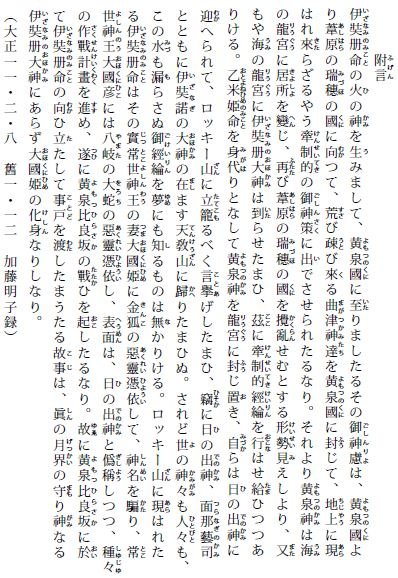 Excerpts from Volume 8 (dictated in Taisho 11, or 1922)
Summary:
- Evil kami in the Tokoyo no Kuni (Land of Eternity) conspire to invade the Island of Onokoro (Self-Tumbling). Izanagi no Mikoto at Mount Tenkyoh orders Hinode no Kami to thwart their conspiracy. (Details in Volume 7)
Tokoyo no Kuni
(Present-day North America) |
Island of Onokoro
(Present-day Japan) |
Evil kami include:
- Oh Kuni-hiko, the self-proclaimed divine king of the Tokoyo no Kuni
- Oh Kuni-hime, the wife of Oh Kuni-hiko
- Hirokuni-wake, a deity under Oh Kuni-hiko
|
Good kami include:
- Izanagi no Mikoto, a high-ranking kami at Mount Tenkyoh (present-day Mount Fuji)
- Hinode no Kami, a great kami (Hinode literally means "sunrise")
|
-
Hinode no Kami rescues Izanami no Mikoto, the wife of Izanagi no Mikoto, from the undersea Dragon Palace, and they are headed for the Tokoyo no Kuni. (Details in Volume 8) Getting wind of it, Oh Kuni-hiko, his wife Oh Kuni-hime, and Hirokuni-wake assume the false names of Hinode no Kami, Izanami no Kami, and Oh Kuni-hiko, respectively.
NB 1: Hinode no Kami and Izanami no Mikoto actually return to Mount Tenkyoh on divine orders, instead of going to the Rocky Mountains in the Land of Eternity.
| Real Name |
Feigned Name |
| Oh Kuni-hiko | Hinode no Kami |
| Oh Kuni-hime | Izanami no Mikoto |
| Hirokuni-wake | Oh Kuni-hiko |
NB 2: Those three impostors pretend to be great kami, probably to lend authority and credence to their conspiracy and make it look like a holy war.
-
The good deities have the edge over the evil ones. Hinode no Kami and Izanami no Mikoto actually return to Mount Tenkyoh on the Island of Onokoro instead of going to the Rocky Mountains in the Land of Eternity. The two kami act as if they deliberately prompted Oh Kuni-hiko and the others to launch their disinformation campaign.
-
As a result, the divine army from Mount Tenkyoh, led by Izanagi no Mikoto and Hinode no Kami, fights against the evil army led by false Izanami no Mikoto (= Oh Kuni-hime) on the Pacific Island of Yomotsu.
-
The story of Izanagi no Mikoto versus Izanami no Mikoto is also found in the Kojiki (Battle at the Even Pass of Hades).
Izanagi goes to the land of the dead called Yomi to bring Izanami back, but finds out that she has already turned into a rotting corpse demon. Scared, Izanagi runs away, which embarrasses Izanami so much that she chases him with other female demons. Izanagi drvies them away by throwing three peaces at them.
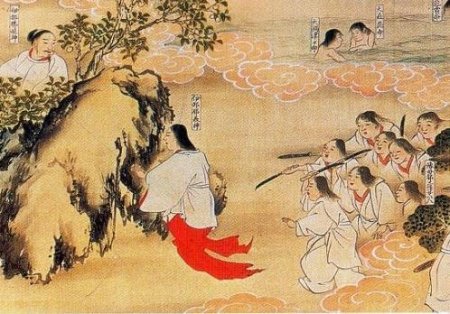 Izanagi (left) at Even Pass of Hades, standing opposite to Izanami (center) and other female demons (right)
Onisaburo says that the Izanami depicted in the Kojiki is the false Izanami (= Oh Kuni-hime), not the genuine Izanami.
As suggested in the story above, Emperor Hirohito may have collaborated with the West as a pawn in the Pacific War, as symbolied by the false Izanami no Mikoto (= Oh Kuni-hime) from the Tokoyo, or present-day North America.
Renowned for his prophetic ability (over 90 percent accuracy), Onisaburo secretly embedded a message in a dozen of 12-syllable poems for Omoto's missionary work (see below) to the effect that the Emperor was an imposter.
 |
The 4th highlighted row (right to left) says: "Ayabe ni tenshi wo kakuseri " (The true emperor is hidden in Ayabe)
The 8th highlighted row (left to right) says: "Imano tenshi nisemono nari " (The current emperor is a false one)
|
Onisaburo had to use this method because in those days the Emperor was deified as an inviolable being, and any open criticism of him would trigger punishment for a charge of lese majeste.
By "Ayabe ni tenshi wo kakuseri " (The true emperor is hidden in Ayabe), Onisaburo hints that he IS the true emperor. Please note that he is not a megalomanic nor does he let his imagination run wild. His message is based on the truth. Onisaburo is an illegitimate son of Prince Taruhito of the House of Arisugawa. Prince Taruhito was first in line to the imperial throne until Prince Yoshihito (= Emperor Taisho in the future) was born, and since Prince Taruhito had no children, Onisaburo could have been appointed emperor.
 Prince Taruhito, the biological father of Onisaburo
For this reason, the Battle on the Island of Yomotsu in Volume 10 of the Monogatari can also be interpreted as the battle between the true Emperor in Omoto and the false Emperor in the Empire of Japan:
The Empire of Japan launched a massive persecution of Omoto twice in Taisho 10 (1921) and Showa 10 (1935), probably to silence Onisaburo becase he divulged the illegitimate blood line of the then Emperor.
The outcome was in favor of Onisaburo and Omoto. They survived the ordeal while the Empire of Japan collapsed and the Emperor denied his divinity.
The "Seal of the Deity of Su" completes the characters of Nippon (Japan) as the 10th Piece of the Kirigami Shinji
A tiny hole in the center of Onisaburo's thumb mark (red portion below) makes it look like  , a symbol of the Deity of Su (Creator) , a symbol of the Deity of Su (Creator)
 Onisaburo's thumb mark, also known as the "Seal of the Deity of Su," shapes like the mark of the Original Deity. (Source: The Aizen-en)
Volume 73 of the Monogatari (dictated in Showa 8, or 1933) describes the kototama (mystical power dwelling in words) of Su, or the Deity of Su, as follows:
Summary:
- In time immemorial when there was no heaven, earth or universe, a single point (
 ) suddenly appeared in the great void. ) suddenly appeared in the great void.
- This point became increasingly limpid and expansive, turning into a kind of circle. Radiating from the circle was divine energy more minuscule than steam, smoke or mist.
-
This divine energy formed a circular zone that in turn wrapped the point. The whole process gave birth to the kototama of Su (
 ) for the first time. ) for the first time.
-
This Su kototama is the great root of all creation in the universe, and also the very origin of the Great Lord Kami.
The above describes how the symbol of the Deity of Su ( ) was born according to the Reikai Monogatari. This may remind some readers of the Big Bang theory. ) was born according to the Reikai Monogatari. This may remind some readers of the Big Bang theory.
The Kirigami Shinji, which requires the use of all the nine pieces, does NOT produce the perfect Nippon (kanji characters for "Japan"), as shown below. What makes the character string complete is the 10th piece - namely, the "Seal of the Deity of Su".
Do you remember the following prophecy of the Kirigami Shinji?
- Japan will perish without the Deguchis in Ayabe, Tamba
Onisaburo, having the "Seal of the Deity of Su" thumb mark, perfected the Kirigami Shinji and fulfilled the wishes of Asahigata and Emperor Kohmei when he met with Sato and received the items in question from the visitor.
To be continued....
Ms. Reiko Deguchi (right) having an interview with Ms. Hisako Ohmuro (center), whose grandfather's older brother was Toranosuke Ohmuro.
Excerpts from The Dec. 2004 edition of the Mu magazine by Gakken, 2004.
Bibliography
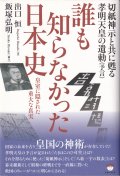 |
An Unknown History of Japan by Hisashi Deguchi and Hiroaki Iidzuka. Hikaru Land, 2016. |
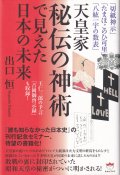 |
A Future of Japan Seen Through the Secret Art of the Imperial Family by Hisashi Deguchi. Hikaru Land, 2017. |
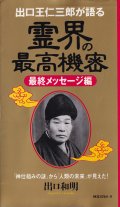 |
Onisaburo Deguchi on Top Secrets of the Spirit World by Yasuaki Deguchi. KK Longsellers, 1999. |
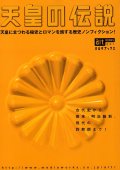 |
The Legend of Japanese Emperors by Media Works. Shufu no Tomo-sha, 1997. |

Click to see excerpts |
The Dec. 2004 edition of the Mu magazine by Gakken, 2004.
Click to see excerpts |
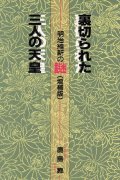 |
The Three Betrayed Emperors of Japan by Noboru Kashima. Shin Kokumin-sha, 1997. |
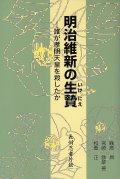 |
Sacrifices to the Meiji Restoration by Noboru Kashima, Tetsuo Miyazaki, and Masashi Matsushige. Shin Kokumin-sha, 1998. |
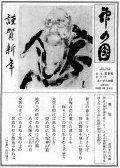 |
The 1998-2003 editions of the Kami no Kuni magazine by the Aizen-en. The Aizen-en, 1998-2003. |
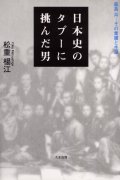 |
A Man Who Wrestled With That Taboo Subject in Japanese History by Yokoh Matsushige. Tama Shuppan, 2003. |
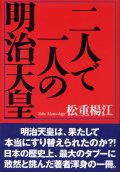 |
Two-For-One Emperor Meiji by Yokoh Matsushige. Tama Shuppan, 2007. |
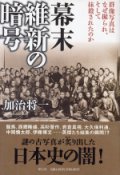 |
The Meiji Restoration Code in the Closing Days of the Tokugawa Shogunate by Masakazu Kaji. Shodensha, 2007. |
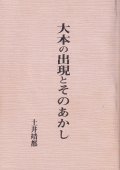 |
The Emergence of Omoto and Its Testament by Yasukuni Doi. The Tensei-sha, Showa 7 (1932). |
|
|
|
